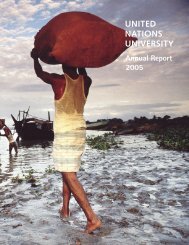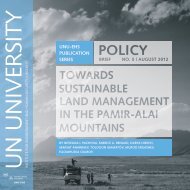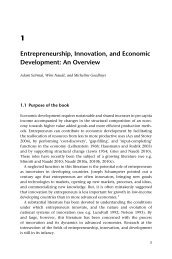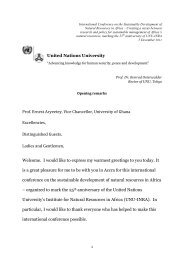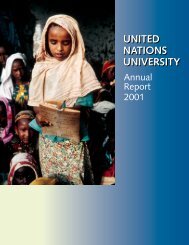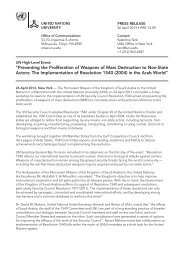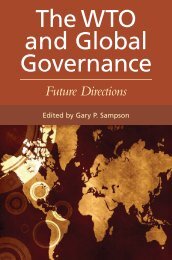Linking Globalization to Poverty in Asia, Latin America and Africa
Linking Globalization to Poverty in Asia, Latin America and Africa
Linking Globalization to Poverty in Asia, Latin America and Africa
Create successful ePaper yourself
Turn your PDF publications into a flip-book with our unique Google optimized e-Paper software.
www.wider.unu.eduNUMBER 3, 2010OverviewDespite the enormous potential ofglobalization <strong>in</strong> accelerat<strong>in</strong>g economicgrowth through greater <strong>in</strong>tegration<strong>in</strong><strong>to</strong> the world economy the impact ofglobalization on poverty reduction hasbeen uneven. <strong>Asia</strong> has been the majorbenefi ciary of globalization where highgrowth rates <strong>and</strong> its labor-<strong>in</strong>tensivepattern contributed <strong>to</strong> a spectacularreduction <strong>in</strong> poverty. In contrast, the<strong>in</strong>tegration process <strong>in</strong> Lat<strong>in</strong> <strong>America</strong> didnot contribute <strong>to</strong> accelerat<strong>in</strong>g growth<strong>and</strong> employment <strong>and</strong> even led, <strong>in</strong> some<strong>in</strong>stances, <strong>to</strong> an <strong>in</strong>formalization of thelabor force. In spite of open<strong>in</strong>g up, thefailure of sub-Saharan <strong>Africa</strong> <strong>to</strong> diversify<strong>and</strong> undergo structural transformationhas led <strong>to</strong> the persistence of low growth<strong>and</strong> debilitat<strong>in</strong>g poverty. While theimpact of globalization on poverty iscontext-specifi c, we argue that countries<strong>in</strong>tent on benefi tt<strong>in</strong>g from globalizationneed <strong>to</strong> adopt a pro-active st<strong>and</strong> <strong>in</strong>formulat<strong>in</strong>g regional <strong>and</strong> nationalstrategies <strong>to</strong> enhance the potentiallypositive effects of globalization <strong>and</strong>moderate the negative effects.Written by MACHIKO NISSANKE ANDERIK THORBECKE© United Nations University, 2010ISBN 978-92-808-3080-4ISSN 1813-5706Licensed under the Creative CommonsDeed “Attribution-NonCommercial-NoDerivs 2.5”<strong>L<strong>in</strong>k<strong>in</strong>g</strong> <strong>Globalization</strong> <strong>to</strong> <strong>Poverty</strong> <strong>in</strong><strong>Asia</strong>, Lat<strong>in</strong> <strong>America</strong> <strong>and</strong> <strong>Africa</strong>GLOBALIZATION AND POVERTY, ALONGSIDE THE ISSUE OFchange epi<strong>to</strong>mize two of the most press<strong>in</strong>g contemporary<strong>in</strong>ternational development issues. Despite the enormous potentialof globalization <strong>in</strong> accelerat<strong>in</strong>g economic growth <strong>and</strong> development throughgreater <strong>in</strong>tegration <strong>in</strong><strong>to</strong> the world economy, the spread <strong>and</strong> transfer oftechnology, <strong>and</strong> the transmission of knowledge, the impact of globalizationon poverty reduction has been uneven <strong>and</strong> even marg<strong>in</strong>al <strong>in</strong> some regions,such as <strong>in</strong> much of sub-Saharan <strong>Africa</strong> (SSA). Both the prevalence <strong>and</strong> depthof poverty <strong>in</strong> many parts of the develop<strong>in</strong>g world rema<strong>in</strong> unacceptably high.A question often raised is whether the actual distribution of ga<strong>in</strong>sfrom globalization is fair <strong>and</strong>, <strong>in</strong> particular, whether the poor benefitproportionately less from globalization <strong>and</strong> could actually be hurt byit under some circumstances. The risks <strong>and</strong> costs brought about byglobalization can be significant for fragile develop<strong>in</strong>g economies <strong>and</strong> theworld’s poor. The downside of globalization is most vividly illum<strong>in</strong>ateddur<strong>in</strong>g times of periodic global f<strong>in</strong>ancial <strong>and</strong> economic crises. The costsof repeated f<strong>in</strong>ancial crises fuelled by the globalization process, at leastuntil the present major recession, have been borne overwhelm<strong>in</strong>gly by thedevelop<strong>in</strong>g world <strong>and</strong> often disproportionately so by the poor who are themost vulnerable. On the other h<strong>and</strong>, the benefits from globalization dur<strong>in</strong>gboom times are often not equally shared with<strong>in</strong> the global community.The fear that the poor have been bypassed, or actually hurt, by globalizationwas highlighted by the f<strong>in</strong>d<strong>in</strong>gs from a number of recent studies, whichpo<strong>in</strong>t <strong>to</strong>wards a cont<strong>in</strong>u<strong>in</strong>g prevalence of high <strong>in</strong>equality <strong>in</strong> the world<strong>in</strong>come distribution, <strong>and</strong> limited <strong>in</strong>come convergence among participat<strong>in</strong>gnational economies <strong>and</strong> across regions.The progress on poverty reduction has also been uneven. The share of thepopulation of develop<strong>in</strong>g countries liv<strong>in</strong>g below US$1.25 per day decl<strong>in</strong>edfrom 52 per cent <strong>to</strong> 25 per cent between 1981 <strong>and</strong> 2005, but this was
www.unu.eduAbout the AuthorsMachiko Nissanke isProfessor of Economics atthe School of Oriental <strong>and</strong><strong>Africa</strong>n Studies, Universityof London. She previouslyworked at BirkbeckCollege, UniversityCollege London <strong>and</strong> theUniversity of Oxford.Erik Thorbecke is theH. E. Babock Professorof Economics, Emeritus,Graduate SchoolProfessor <strong>and</strong> formerDirec<strong>to</strong>r of the Programon Comparative EconomicDevelopment.ma<strong>in</strong>ly achieved by the substantialreduction of the poor <strong>in</strong> <strong>Asia</strong>, <strong>in</strong>particular <strong>in</strong> Ch<strong>in</strong>a. Furthermore,over the period 1981–2005, the<strong>to</strong>tal number of people liv<strong>in</strong>gunder US$2 per day has actually<strong>in</strong>creased worldwide by about 2million <strong>to</strong> 2.53 billion <strong>in</strong> 2005. Thereis a clear disparity <strong>in</strong> regional trends<strong>in</strong> poverty reduction. While East<strong>Asia</strong> <strong>and</strong> the Pacific experiencedthe sharpest reduction <strong>in</strong> theproportion of poor liv<strong>in</strong>g belowUS$1.25 per day from 78 per cent<strong>to</strong> 17 per cent, between 1981 <strong>and</strong>2005, the poverty headcount ratiorema<strong>in</strong>ed very high <strong>in</strong> sub-Saharan<strong>Africa</strong> (around 52 per cent) <strong>and</strong> thenumber of poor almost doubledfrom 212 <strong>to</strong> 388 million.Though any observed trend <strong>in</strong>poverty <strong>and</strong> <strong>in</strong>come <strong>in</strong>equalitycannot be exclusively oreven ma<strong>in</strong>ly attributed <strong>to</strong> the‘globalization’ effect as such, thesevarious estimates cannot dismissthe concerns raised that theglobalization process may havehad adverse effects on <strong>in</strong>comedistribution <strong>and</strong> on povertyamong some segments of thepopulation. Indeed, while mos<strong>to</strong>bjective observers would arguethat globalization is likely <strong>to</strong> havecontributed <strong>to</strong> poverty alleviationon a net basis, it is also known <strong>to</strong>have created w<strong>in</strong>ners <strong>and</strong> losersat numerous levels throughoutmodern his<strong>to</strong>ry. These concernshave generated a passionate debateworldwide as well as a powerfulanti-globalization movement.The extent of controversysurround<strong>in</strong>g this debate reflectsthe fact that globalization is not aprocess, proceed<strong>in</strong>g neutrally <strong>in</strong> apolicy vacuum; rather, it is a policy<strong>in</strong>duced condition. <strong>Globalization</strong>is not purely driven by newtechnological <strong>in</strong>novations <strong>and</strong>progress or by ‘neutral’ market forces<strong>and</strong> other <strong>in</strong>escapable sociopoliticalforces, as often depicted <strong>in</strong> popularwrit<strong>in</strong>gs. In particular, the currentphase of globalization is, <strong>to</strong> a certa<strong>in</strong>extent, an outcome emerg<strong>in</strong>gfrom the global acceptance <strong>and</strong>diffusion of the economic policyparadigm, emphasiz<strong>in</strong>g benefits <strong>and</strong>positive features of the liberalizedpolicy regime characterized by theWash<strong>in</strong>g<strong>to</strong>n Consensus.As the process of economic<strong>in</strong>tegration has <strong>in</strong>tensified s<strong>in</strong>cethe 1990s, the question of howglobalization affects the world’spoor has become one of the centralissues <strong>in</strong> <strong>in</strong>ternational politicaleconomy <strong>and</strong> <strong>in</strong>ternational relations.However, the precise nature ofthe various mechanisms throughwhich globalization has altered thepattern of <strong>in</strong>come distribution <strong>and</strong>the conditions fac<strong>in</strong>g the world’spoor are yet <strong>to</strong> be carefully analysed.This is because the globalization–poverty relationship is complex,non-l<strong>in</strong>ear, <strong>and</strong> heterogeneous,<strong>in</strong>volv<strong>in</strong>g multifaceted channels.Besides the ‘growth’ effects ofglobalization on poverty (thatis, the effects of globalizationon poverty transmitted througheconomic growth), the <strong>in</strong>tegrationprocess is known <strong>to</strong> create w<strong>in</strong>ners<strong>and</strong> losers directly through otherchannels, affect<strong>in</strong>g both vertical<strong>and</strong> horizontal <strong>in</strong>equalities. Becausethese multifaceted channels <strong>in</strong>teractdynamically over space <strong>and</strong> time,the net effects of globalization onthe poor can only be judged on thebasis of context-specific empiricalstudies. Cross-country studiesrequir<strong>in</strong>g precise measurements<strong>and</strong> def<strong>in</strong>ition of the two key2 Policy Brief
www.wider.unu.educoncepts—globalization <strong>and</strong>poverty—tend <strong>to</strong> fail <strong>to</strong> give robust<strong>in</strong>sights <strong>in</strong><strong>to</strong> this critical nexus. Bothconcepts are multidimensional, <strong>and</strong>not easily captured <strong>in</strong> a composite<strong>in</strong>dex that may be used <strong>in</strong> amean<strong>in</strong>gful manner <strong>in</strong> cross-countrycomparative studies or regressions.Build<strong>in</strong>g on earlier research projects,UNU-WIDER <strong>in</strong>itiated a projec<strong>to</strong>n ‘The Impact of <strong>Globalization</strong>on the World’s Poor’ <strong>in</strong> 2004, <strong>to</strong>deepen our underst<strong>and</strong><strong>in</strong>g of howconditions fac<strong>in</strong>g the world’s poorhave been evolv<strong>in</strong>g under the forcesof globalization with emphasis onthe economic manifestations ofthose forces. Various channels <strong>and</strong>transmission mechanisms wereidentified <strong>and</strong> explored throughwhich the process of globalizationaffects different aspects <strong>and</strong>dimensions of poverty <strong>in</strong> thedevelop<strong>in</strong>g world. This was the ma<strong>in</strong>theme of the first methodological<strong>and</strong> conceptual conference heldunder the auspices of this project <strong>in</strong>Hels<strong>in</strong>ki <strong>in</strong> 2004.Subsequently three regionalconferences focus<strong>in</strong>g, respectively,on <strong>Asia</strong> (held <strong>in</strong> Tokyo), Lat<strong>in</strong><strong>America</strong> (Rio de Janeiro), <strong>and</strong> <strong>Africa</strong>(Johannesburg) were organized<strong>to</strong> help identify <strong>and</strong> illustrate thedifferential effects of globalizationon growth, <strong>in</strong>equality, <strong>and</strong>poverty <strong>in</strong> the three cont<strong>in</strong>ents.Approximately sixty specificcase studies were <strong>in</strong>itiated <strong>and</strong>completed under the auspicesof this project. These studies are<strong>in</strong>corporated <strong>in</strong> the three publishedvolumes, three special issues ofjournals <strong>and</strong> other publicationsresult<strong>in</strong>g from this project (thecomplete list of publications is givenat the end of this policy brief).Focus<strong>in</strong>g on dist<strong>in</strong>ct manifestationsof globalization <strong>and</strong> channelsthrough which they affectpoverty, these case studiescover the spectrum from broadmacroeconomic regional <strong>and</strong>country analyses <strong>to</strong> micro-orientedvillage studies on each of the threecont<strong>in</strong>ents. These case studiesillustrate clearly that the impac<strong>to</strong>f globalization on poverty isextremely context-specific.Significant differences <strong>in</strong> <strong>in</strong>itialconditions as well as dist<strong>in</strong>ct<strong>in</strong>ternal dynamic processes of<strong>in</strong>stitutional <strong>and</strong> sociopoliticalchange triggered by the forcesof economic <strong>in</strong>tegration have<strong>in</strong>fluenced the poor <strong>in</strong> <strong>Asia</strong>,Lat<strong>in</strong> <strong>America</strong>, <strong>and</strong> <strong>Africa</strong> <strong>in</strong>quite dissimilar ways. There aredist<strong>in</strong>ctive characteristics, specific<strong>to</strong> each of the three develop<strong>in</strong>gregions, shap<strong>in</strong>g the ways <strong>in</strong> whichglobalization has affected the poor.This merits a comparative analysisof each region’s experiences withglobalization <strong>and</strong> <strong>in</strong>tegration.Naturally, any attempt atestimat<strong>in</strong>g rigorously the impac<strong>to</strong>f the globalization process onsocioeconomic performance (<strong>and</strong>more specifically on poverty)faces the almost <strong>in</strong>surmountableobstacle of the lack of a plausiblecounterfactual scenario. In order<strong>to</strong> derive robust <strong>in</strong>ferences, onewould have <strong>to</strong> compare theperformance under the presentforces of globalization <strong>to</strong> analternative scenario of no or limitedglobalization. With<strong>in</strong> limits, thiscould be done very approximately<strong>and</strong> roughly with<strong>in</strong> a computablegeneral equilibrium model for agiven country or region of a countrybut this task is clearly <strong>in</strong>feasible forcont<strong>in</strong>ents as large <strong>and</strong> diverse as<strong>Asia</strong>, Lat<strong>in</strong> <strong>America</strong>, <strong>and</strong> <strong>Africa</strong>.This Policy Brief is publishedwith<strong>in</strong> the UNU-WIDERresearch project ‘Impac<strong>to</strong>f <strong>Globalization</strong> on theWorld’s Poor’ directed byErik Thorbecke <strong>and</strong> MachikoNissanke. More detailedf<strong>in</strong>d<strong>in</strong>gs are set out <strong>in</strong> a seriesof work<strong>in</strong>g papers (available <strong>to</strong>download free at:www.wider.unu.edu):<strong>L<strong>in</strong>k<strong>in</strong>g</strong> <strong>Globalization</strong> <strong>to</strong> <strong>Poverty</strong> <strong>in</strong> <strong>Asia</strong>, Lat<strong>in</strong> <strong>America</strong>, <strong>and</strong> <strong>Africa</strong> 3
www.unu.eduInstead, we first attempt <strong>to</strong> describesome major recent socioeconomictrends on each of these cont<strong>in</strong>entsthat one can legitimately claim were<strong>in</strong>fluenced by the globalizationprocess even if they were, <strong>in</strong> fact,the net consequences of a wholeseries of fac<strong>to</strong>rs with some ofthem <strong>in</strong>dependent of the forces ofglobalization. Further, while thereare clear <strong>in</strong>tercont<strong>in</strong>ental differences<strong>in</strong> the effects of globalization on thepoor, it is also true that significantdifferences can prevail with<strong>in</strong> eachregional block as well. Hence, thegeneral picture we pa<strong>in</strong>t with abroad brush can usefully serve as abackdrop <strong>to</strong> the sixty specific casestudies generated by this project.The next section presents abrief summary of our analysis ofthe channels <strong>and</strong> transmissionmechanisms through which theprocess of globalization affectsdifferent aspects of poverty <strong>in</strong>the develop<strong>in</strong>g world. Section 3provides a comparative analysisof the differential impact ofTransmission Channels: The<strong>Globalization</strong>-Openness-Growth-Distribution (Inequality)-<strong>Poverty</strong> Nexus<strong>Globalization</strong> Openness KuznetsTradeCapitalLaborTechnologyKnowledge++GrowthDistribution(Inequality)-Classical +Modern -+<strong>Poverty</strong>globalization—operat<strong>in</strong>g throughthese channels—on the poor<strong>in</strong> the three different regions.F<strong>in</strong>ally, Section 4 suggests apolicy framework that could makeglobalization more pro-poor.2 Channels <strong>L<strong>in</strong>k<strong>in</strong>g</strong> <strong>Globalization</strong><strong>to</strong> <strong>Poverty</strong>What are the transmissionmechanisms through which theprocess of globalization affectspoverty directly <strong>and</strong> <strong>in</strong>directly?The first <strong>and</strong> foremost of thesemechanisms is the growth<strong>in</strong>equality-povertychannel. Figure.1 is our attempt <strong>to</strong> illustrateschematically the various criticall<strong>in</strong>ks of the causal cha<strong>in</strong> runn<strong>in</strong>gfrom globalization (openness)<strong>to</strong> poverty, focus<strong>in</strong>g on the mostcritical l<strong>in</strong>ks <strong>and</strong> abstract<strong>in</strong>g fromsome feedback effects.<strong>Globalization</strong>, as def<strong>in</strong>ed <strong>in</strong> thisproject, means greater economic<strong>in</strong>tegration manifested through<strong>in</strong>creased openness via numeroustransmission mechanisms such astrade <strong>and</strong> <strong>in</strong>vestment liberalization,movements of capital, labourmigration across borders <strong>and</strong>with<strong>in</strong> countries, the nature oftechnological change <strong>and</strong> diffusionof knowledge <strong>and</strong> technology,worldwide <strong>in</strong>formation flows, <strong>and</strong><strong>in</strong>stitutional environments. Thesemechanisms, <strong>in</strong> turn, affect povertythrough two different paths: first,through their contribution <strong>to</strong> thegrowth channel (<strong>in</strong> the upper par<strong>to</strong>f the diagram <strong>in</strong> Figure 1) <strong>and</strong>,second, through their impact on<strong>in</strong>come distribution (<strong>in</strong> the lowerpart of the diagram).The specific l<strong>in</strong>ks shown <strong>in</strong> thisFigure are from openness <strong>to</strong>growth, from openness <strong>to</strong> <strong>in</strong>come4 Policy Brief
www.wider.unu.edudistribution (<strong>in</strong>equality), fromgrowth <strong>to</strong> <strong>in</strong>come distribution<strong>and</strong> vice versa, from growth<strong>to</strong> poverty, <strong>and</strong> from <strong>in</strong>comedistribution <strong>to</strong> poverty, respectively.In turn, the two ma<strong>in</strong> channels ofglobalization—the ‘growth’ <strong>and</strong>‘distribution’ channels—further<strong>in</strong>teract dynamically over time<strong>to</strong> produce a growth–<strong>in</strong>equality–poverty triangular relationship,which is captured by the righth<strong>and</strong> side triangle of the Figuredescrib<strong>in</strong>g the arithmetic-statisticalrelationship among growth,<strong>in</strong>equality, <strong>and</strong> poverty.Each subset of l<strong>in</strong>ks embedded<strong>in</strong> the globalization (openness)–growth–<strong>in</strong>come distribution–povertynexus, schematically illustrated <strong>in</strong>the Figure, can be contentious<strong>and</strong> controversial. For example,the direction of causality <strong>in</strong> theopenness–growth l<strong>in</strong>k is still be<strong>in</strong>gdebated (the consensus view isthat trade contributes <strong>to</strong> growthrather than vice versa) as well ashow trade <strong>and</strong> capital flows couldbe <strong>in</strong>terl<strong>in</strong>ked <strong>in</strong><strong>to</strong> a virtuous circle.In this context it can be argued thatthe positive openness–growth l<strong>in</strong>kis neither au<strong>to</strong>matically guaranteednor universally observable, as thegrowth-enhanc<strong>in</strong>g effects of tradeopenness depend critically on theway <strong>and</strong> extent <strong>to</strong> which a country is<strong>in</strong>tegrated <strong>in</strong><strong>to</strong> the global economy.Indeed, a greater <strong>in</strong>tegration/openness process does notnecessarily ensure un<strong>in</strong>terruptedgrowth spells. Rather, it also entailsaccept<strong>in</strong>g greater downside riskof the contagion effects of crises,as demonstrated by the globallysynchronized slowdown that hasengulfed all the economies <strong>in</strong> thedevelop<strong>in</strong>g world s<strong>in</strong>ceSeptember 2008.Further, relat<strong>in</strong>g the causal cha<strong>in</strong>Publications from the Project‘Impact of <strong>Globalization</strong> on the World’s Poor’The Impact of <strong>Globalization</strong> on the World’s Poor: Tranmission MechanismsEdited by Machiko Nissanke <strong>and</strong> Erik ThorbeckeBas<strong>in</strong>g<strong>to</strong>ke Palgrave Macmillan, 2006Chapter 1 OverviewMachiko Nissanke <strong>and</strong> Erik ThorbeckeChapter 2 Channels <strong>and</strong> Policy Debate <strong>in</strong> the <strong>Globalization</strong>–Inequality–<strong>Poverty</strong>NexusMachiko Nissanke <strong>and</strong> Erik ThorbeckeChapter 3 The Relationship between Income Inequality,<strong>Poverty</strong> <strong>and</strong> <strong>Globalization</strong>Almas HeshmatiChapter 4 <strong>Globalization</strong> <strong>and</strong> <strong>Poverty</strong> Trends across Regions: The Roleof Variation <strong>in</strong> the Income <strong>and</strong> Inequality Elasticities of <strong>Poverty</strong>Adriaan Kalwij <strong>and</strong> Arjan VerschoorChapter 5 Look<strong>in</strong>g Beyond Averages <strong>in</strong> the Trade <strong>and</strong> <strong>Poverty</strong> DebateMart<strong>in</strong> RavallionChapter 6 <strong>Globalization</strong> <strong>and</strong> Rural <strong>Poverty</strong>Pranab BardhanChapter 7 <strong>Globalization</strong>, Production <strong>and</strong> <strong>Poverty</strong>Rhys Jenk<strong>in</strong>sChapter 8 The Role of Information <strong>in</strong> Technology Adoption under <strong>Poverty</strong>J<strong>in</strong>hua ZhaoChapter 9 Trade Openness <strong>and</strong> Vulnerability <strong>in</strong> Central <strong>and</strong> Eastern EuropePierluigi Montalbano, Aless<strong>and</strong>ro Federici, Umber<strong>to</strong> Triulzi <strong>and</strong> Carlo PietrobelliChapter 10 <strong>Globalization</strong>, <strong>Poverty</strong>, Inequality <strong>and</strong> Insecurity: Some Insightsfrom the Economics of Happ<strong>in</strong>essCarol GrahamChapter 11 Expla<strong>in</strong><strong>in</strong>g Threshold Effects of <strong>Globalization</strong> on <strong>Poverty</strong>:An Institutional PerspectiveAlice S<strong>in</strong>dz<strong>in</strong>greChapter 12 <strong>Globalization</strong>, <strong>Poverty</strong> <strong>and</strong> Inequality: What Is the Relationship?What Can Be Done?Kaushik Basu<strong>L<strong>in</strong>k<strong>in</strong>g</strong> <strong>Globalization</strong> <strong>to</strong> <strong>Poverty</strong> <strong>in</strong> <strong>Asia</strong>, Lat<strong>in</strong> <strong>America</strong>, <strong>and</strong> <strong>Africa</strong> 5
www.unu.eduPublications from the Project‘Impact of <strong>Globalization</strong> on the World’s Poor’<strong>Globalization</strong> <strong>and</strong> the Poor <strong>in</strong> <strong>Asia</strong>: Can Shared Growth be Susta<strong>in</strong>ed?Edited by Machiko Nissanke <strong>and</strong> Erik ThorbeckeBas<strong>in</strong>gs<strong>to</strong>ke Palgrave Macmillan, 2008Chapter 1 <strong>Globalization</strong> <strong>and</strong> <strong>Poverty</strong> <strong>in</strong> <strong>Asia</strong>: Can SharedGrowth be Susta<strong>in</strong>ed?Machiko Nissanke <strong>and</strong> Erik ThorbeckeChapter 2 Pro-Poor Growth: The <strong>Asia</strong>n ExperienceNanak Kakwani <strong>and</strong> Hyun H. SonChapter 3 How Does Vietnam’s Accession <strong>to</strong> the World Trade OrganizationChange the Spatial Incidence of <strong>Poverty</strong>?Tomoki Fujii <strong>and</strong> David Rol<strong>and</strong>-HolstChapter 4 Trade, Migration, <strong>and</strong> <strong>Poverty</strong> Reduction <strong>in</strong> the Globaliz<strong>in</strong>gEconomy: The Case of the Philipp<strong>in</strong>esYasuyuki Sawada <strong>and</strong> Jonna P. EstudilloChapter 5 Threshold Estimation on the <strong>Globalization</strong>-<strong>Poverty</strong> Nexus:Evidence from Ch<strong>in</strong>aZhicheng LiangChapter 6 Economic Development Strategy, Openness <strong>and</strong> Rural <strong>Poverty</strong>:A Framework <strong>and</strong> Ch<strong>in</strong>a’s ExperiencesJust<strong>in</strong> Yifu L<strong>in</strong> <strong>and</strong> Peil<strong>in</strong> L<strong>in</strong>Chapter 7 Vulnerability <strong>to</strong> <strong>Globalization</strong> <strong>in</strong> India:Relative Rank<strong>in</strong>gs of States Us<strong>in</strong>g Fuzzy ModelsK. S. Kavi Kumar <strong>and</strong> Br<strong>in</strong>da ViswanathanChapter 8 Resource-Poor Farmers <strong>in</strong> South India:On the Marg<strong>in</strong>s or Frontiers of <strong>Globalization</strong>Rimjhim M. AggarwalChapter 9 Credit Constra<strong>in</strong>ts as a Barrier <strong>to</strong> Technology Adoptionby the Poor: Lessons from South Indian Small-Scale FisheriesXavier G<strong>in</strong>é <strong>and</strong> Stephan KlonnerChapter 10 Trade Liberalization, Environment <strong>and</strong> <strong>Poverty</strong>:A Develop<strong>in</strong>g Country PerspectiveMahvash Saeed Qureshifrom <strong>in</strong>come <strong>and</strong> wealth <strong>in</strong>equality<strong>to</strong> growth (the ‘<strong>in</strong>equality–growth’l<strong>in</strong>k), there are two conflict<strong>in</strong>gtheoretical str<strong>and</strong>s: the traditional(classical) approach <strong>and</strong> the ‘new’political economy of developmenttheories (modern). Whilst the formeremphasizes the growth-enhanc<strong>in</strong>geffects of <strong>in</strong>come <strong>in</strong>equality <strong>and</strong>wealth <strong>in</strong>equality through thesav<strong>in</strong>g-enhanc<strong>in</strong>g effects (the richsave proportionately more thanthe poor) as well as the existenceof <strong>in</strong>vestment <strong>in</strong>divisibilities <strong>and</strong><strong>in</strong>centive effects, the latter l<strong>in</strong>ksgreater <strong>in</strong>equality <strong>to</strong> reducedgrowth through various conditions.These conditions <strong>in</strong>clude thediffusion of political <strong>and</strong> social<strong>in</strong>stability lead<strong>in</strong>g <strong>to</strong> greateruncerta<strong>in</strong>ty <strong>and</strong> lower <strong>in</strong>vestment,unproductive rent-seek<strong>in</strong>gactivities, high transaction costs,<strong>and</strong> <strong>in</strong>creased <strong>in</strong>security of propertyrights. The Kuznets hypothesis ofthe <strong>in</strong>verted U-shaped relationshipbetween growth <strong>and</strong> <strong>in</strong>equalitythat exam<strong>in</strong>es the opposite causalflow (i.e., the ‘growth–<strong>in</strong>equality’l<strong>in</strong>k) is also challenged by a numberof recent studies. Thus, the newpolitical economy of developmentapproach suggests that growthpatterns yield<strong>in</strong>g more <strong>in</strong>equalitywould, <strong>in</strong> turn, engender lowerfuture growth paths result<strong>in</strong>g <strong>in</strong>less of a growth-<strong>in</strong>duced povertyreduction, as Figure 1 illustrates.Thus, we argued that whileglobalization-<strong>in</strong>duced growthmay benefit the poor, the ultimatepoverty reduction effects dependon how the growth pattern affects<strong>in</strong>come distribution, as <strong>in</strong>equalityacts as the filter between growth<strong>and</strong> poverty reduction. Effectivepoverty reduction requires somecomb<strong>in</strong>ation of higher growth <strong>and</strong>a more pro-poor distribution of the6 Policy Brief
www.wider.unu.eduga<strong>in</strong>s from growth.In addition, several specific featuresassociated with the current phaseof globalization have contributed<strong>to</strong> possible adverse effects onthe poor. These <strong>in</strong>clude: (a) thenature of technical changes biased<strong>in</strong> favour of capital <strong>and</strong> aga<strong>in</strong>stunskilled labour, the asymmetricalaccess <strong>to</strong> new technology <strong>and</strong>knowledge, <strong>and</strong> the unevenprocess of technology diffusion;(b) the often perverse pattern of<strong>in</strong>ternational migration which tends<strong>to</strong> encourage a migration of skilledlabour from develop<strong>in</strong>g countries<strong>to</strong> developed countries, whileunskilled labour migration tends<strong>to</strong> be strictly controlled by legalabout the <strong>in</strong>creased vulnerabilityof the poor <strong>to</strong> globalization forcesthat generate greater fluctuations<strong>in</strong> <strong>in</strong>come <strong>and</strong> expenditure causedby global shocks, such as thevarious f<strong>in</strong>ancial crises that havehit Lat<strong>in</strong> <strong>America</strong> <strong>and</strong> <strong>Asia</strong> <strong>in</strong> thelast two decades or the ongo<strong>in</strong>gglobal f<strong>in</strong>ancial crisis <strong>and</strong> food crisis.There is significant evidence thatthese repeated shocks have hurtthe poor disproportionately. Thus,while globalization can be a majoreng<strong>in</strong>e for growth, it is critical <strong>to</strong>put <strong>in</strong> place strong <strong>in</strong>stitutions thatmediate the various channels <strong>and</strong>mechanisms through which theglobalization process <strong>in</strong>fluencespoverty. Indeed, <strong>in</strong>stitutions act as<strong>Globalization</strong> <strong>and</strong> pover ty, alongside climate change,epi<strong>to</strong>mize two of the most press<strong>in</strong>g contemporar y<strong>in</strong>ternational development issuesrestrictions <strong>in</strong> developed countries;(c) the perverse movements ofcapital, such as <strong>in</strong> the form ofcapital flight from develop<strong>in</strong>g oremerg<strong>in</strong>g market economies <strong>to</strong>safe havens <strong>in</strong> the rich countries ordiversification f<strong>in</strong>ance characteriz<strong>in</strong>gportfolio capital flows conductedthrough asset swapp<strong>in</strong>g for riskhedg<strong>in</strong>g <strong>and</strong> shedd<strong>in</strong>g, whichresults <strong>in</strong> global macro imbalances<strong>and</strong> periodical f<strong>in</strong>ancial crises, <strong>and</strong>;(d) uneven, skewed foreign direct<strong>in</strong>vestment (FDI) flows, which havenot necessarily guaranteed hostdevelop<strong>in</strong>g countries access <strong>to</strong>potential benefits of management<strong>and</strong> knowledge transfer. Thesefeatures have affected, <strong>in</strong> a numberof <strong>in</strong>stances, the functional <strong>in</strong>comedistribution between labour <strong>and</strong>capital aga<strong>in</strong>st the former.Concerns are particularly stronga filter <strong>in</strong>tensify<strong>in</strong>g or h<strong>in</strong>der<strong>in</strong>g thepositive <strong>and</strong> negative pass-throughbetween globalization <strong>and</strong> poverty<strong>and</strong> can help expla<strong>in</strong> the diversity,heterogeneity, <strong>and</strong> non-l<strong>in</strong>earityof outcomes. Examples of such<strong>in</strong>stitutions, operat<strong>in</strong>g as safety nets,are discussed <strong>in</strong> the comparativeanalysis that follows.3 How did <strong>Globalization</strong> Affectthe Poor <strong>in</strong> <strong>Asia</strong>, Lat<strong>in</strong> <strong>America</strong>,<strong>and</strong> <strong>Africa</strong>?Emerg<strong>in</strong>g empirical evidenceon the recent <strong>in</strong>crease <strong>in</strong> world<strong>in</strong>come disparity between therich <strong>and</strong> the poor can at least bepartially attributed <strong>to</strong> the forcesshap<strong>in</strong>g the current process ofglobalization. In particular, theobserved ‘big time’ divergence <strong>in</strong><strong>in</strong>ter-country <strong>in</strong>come levels (wheneach country is weighted equally)<strong>L<strong>in</strong>k<strong>in</strong>g</strong> <strong>Globalization</strong> <strong>to</strong> <strong>Poverty</strong> <strong>in</strong> <strong>Asia</strong>, Lat<strong>in</strong> <strong>America</strong>, <strong>and</strong> <strong>Africa</strong>
www.unu.educalls <strong>in</strong><strong>to</strong> question the validity ofthe openness-<strong>in</strong>duced <strong>in</strong>comeconvergence thesis. The reality isthat the mere adoption of opentrade <strong>and</strong> <strong>in</strong>vestment regimesdoes not guarantee, or necessarilypromote, develop<strong>in</strong>g countries’entry <strong>in</strong><strong>to</strong> the ‘<strong>in</strong>come convergenceclub’. It can be argued that theconundrum of the persistent‘non-convergence’ of world percapita <strong>in</strong>come should be explicitlyaddressed <strong>in</strong> terms of structuralfeatures of the global economicrelationships as they evolvedover time <strong>and</strong> <strong>in</strong>stitutional <strong>and</strong>sociopolitical conditions found <strong>in</strong>participat<strong>in</strong>g countries. The <strong>in</strong>comeconvergence trend among nationhave not succeeded <strong>in</strong> reach<strong>in</strong>gthe take-off po<strong>in</strong>t necessary forbenefit<strong>in</strong>g from the positive forcesof globalization. Above all, countriesneed <strong>to</strong> have reached the take-offpo<strong>in</strong>t, as the effects of <strong>in</strong>ternationaltrade on growth are criticallydependent on the structure ofgrowth <strong>and</strong> pattern of specialization<strong>and</strong> <strong>in</strong>tegration. In terms of the<strong>in</strong>ter-sec<strong>to</strong>ral growth pattern,evidence shows that <strong>in</strong> earlydevelopment stages the growth ofagriculture has a far greater impac<strong>to</strong>n poverty than the growth of othersec<strong>to</strong>rs. For example, the bulk ofpoverty reduction <strong>in</strong> Ch<strong>in</strong>a occurreddur<strong>in</strong>g the phase of agriculturalde-collectivization <strong>and</strong> <strong>in</strong>creasesThe risks <strong>and</strong> costs brought about by globalization can besignificant for fragile develop<strong>in</strong>g economiesstates, <strong>to</strong> the extent that it has beenobserved his<strong>to</strong>rically, is likely <strong>to</strong> beexpla<strong>in</strong>ed more effectively by thespecific nature of the <strong>in</strong>tegration<strong>and</strong> specialization process followedby subgroups of countries, ratherthan by the degree of openness ofthe trade <strong>and</strong> <strong>in</strong>vestment regimesper se, as often claimed.A theoretical study undertakenunder the auspices of the presentproject <strong>and</strong> based on a ‘hum<strong>and</strong>evelopment trap model’ showedthat <strong>in</strong> the presence of multipleequilibria, development <strong>and</strong>underdevelopment can coexist assteady states under globalization.This study concluded thatglobalization is a necessary, butnot a sufficient, condition forconvergence <strong>to</strong> development.Indeed, many poor countries thathave opened their economies s<strong>in</strong>cethe 1980s have fallen beh<strong>in</strong>d, <strong>and</strong><strong>in</strong> food prices procurement before1980, rather than <strong>in</strong> the subsequenttrade-open<strong>in</strong>g phase. As will beseen <strong>in</strong> the comparative analysis,countries that went throughan early <strong>and</strong> smooth structuraltransformation, as <strong>in</strong> most of <strong>Asia</strong>,were much more successful <strong>in</strong>generat<strong>in</strong>g a shared-growth processbenefitt<strong>in</strong>g the poor than countriesthat delayed or failed their structuraltransformation process, as is typicalof SSA.In terms of patterns of specializationa country specializ<strong>in</strong>g <strong>in</strong> an <strong>in</strong>dustryendowed with a larger positiveexternality would experience afaster growth rate compared witha trad<strong>in</strong>g partner that specializes <strong>in</strong>an <strong>in</strong>dustry with weaker spillovereffects. Thus, the growth ratesof two trad<strong>in</strong>g countries coulddiffer considerably, depend<strong>in</strong>gon the pattern of specialization. A8 Policy Brief
country with an <strong>in</strong>itial comparativeadvantage <strong>in</strong> ‘non-dynamic’ sec<strong>to</strong>rsmay end up <strong>in</strong> a low equilibriumtrap through the evolv<strong>in</strong>g patternsof production <strong>and</strong> trade. Similarly,the effects of FDI on host economiesdiverge enormously, depend<strong>in</strong>g onthe sec<strong>to</strong>rs <strong>in</strong><strong>to</strong> which transnationalcorporations (TNCs) are attracted<strong>to</strong> move <strong>in</strong> <strong>and</strong> <strong>in</strong>vest. Low‐<strong>in</strong>comedevelop<strong>in</strong>g countries tend <strong>to</strong>attract natural resource-based FDI<strong>in</strong> extract<strong>in</strong>g m<strong>in</strong>eral resources orFDI geared <strong>to</strong>wards the lower endof TNCs’ vertical <strong>in</strong>tegrated globaloperations (their global valuecha<strong>in</strong>) such as simple assemblyl<strong>in</strong>e operations. These sec<strong>to</strong>rs <strong>and</strong>activities are characterized bylimited dynamic externalities, as wellas knowledge <strong>and</strong> skill spillovers.In general, globalizationexperiences <strong>in</strong> the South tend <strong>to</strong>be very heterogeneous. In thiscontext, we argue that develop<strong>in</strong>gcountries have <strong>to</strong> undergosubstantial changes <strong>in</strong> their trade<strong>and</strong> production structures, so as<strong>to</strong> be able <strong>to</strong> reap more benefitsfrom the dynamic forces unleashedby globalization <strong>and</strong> experience<strong>in</strong>come convergence. Indeed, sharpdivergences have emerged <strong>in</strong> thedevelopment paths followed bydifferent countries <strong>in</strong> the South overrecent decades.These divergences can be expla<strong>in</strong>edby the dist<strong>in</strong>ct <strong>in</strong>ternal patternsof economic growth <strong>and</strong> formsof <strong>in</strong>tegration adopted. As aconsequence some countries <strong>in</strong> theSouth were able <strong>to</strong> benefit fromvirtuous cycles of globalization<strong>in</strong>ducedgrowth, while others wereleft beh<strong>in</strong>d <strong>in</strong> vicious cycles ofglobalization-<strong>in</strong>duced decl<strong>in</strong>e. No<strong>to</strong>nly did the growth rates divergePublications from the Project‘Impact of <strong>Globalization</strong> on the World’s Poor’The Poor Under <strong>Globalization</strong> <strong>in</strong> <strong>Asia</strong>, Lat<strong>in</strong> <strong>America</strong> <strong>and</strong> <strong>Africa</strong>Edited by Machiko Nissanke <strong>and</strong> Erik ThorbeckeOxford University Press, 2010Chapter 1 Comparative Analysis of the <strong>Globalization</strong>–<strong>Poverty</strong> Nexus <strong>in</strong> <strong>Asia</strong>,Lat<strong>in</strong> <strong>America</strong> <strong>and</strong> <strong>Africa</strong>Machiko Nissanke <strong>and</strong> Erik ThorbeckeChapter 2 <strong>Globalization</strong> <strong>and</strong> the Human Development TrapDavid Mayer-FoulkesChapter 3 <strong>Globalization</strong>, Literacy Levels <strong>and</strong> Economic DevelopmentAlok BhargavaChapter 4 <strong>Asia</strong>’s Labour-Driven Growth, Fly<strong>in</strong>g Geese Style: Types of Trade,FDI <strong>and</strong> Institutions Matter for the PoorTeru<strong>to</strong>mo OzawaChapter 5 <strong>Globalization</strong>, Growth <strong>and</strong> <strong>Poverty</strong> <strong>in</strong> IndiaN. R. Bhanumurthy <strong>and</strong> Arup MitraChapter 6 <strong>Globalization</strong> <strong>and</strong> Rural <strong>Poverty</strong>: Perspectives from a SocialObserva<strong>to</strong>ry <strong>in</strong> the Philipp<strong>in</strong>esYujiro HayamiChapter 7 <strong>Globalization</strong> <strong>and</strong> the Urban Poor <strong>in</strong> Ch<strong>in</strong>aY<strong>in</strong> Zhang <strong>and</strong> Guanghua WanChapter 8 Trade Liberalization, Employment Flows <strong>and</strong> WageInequality <strong>in</strong> BrazilFrancisco H. G. Ferreira, Phillippe G. Leite <strong>and</strong> Matthew Wai-PoiChapter 9 <strong>Globalization</strong> <strong>and</strong> the Urban PoorJanice E. PerlmanChapter 10 <strong>Globalization</strong>, Crop Choice <strong>and</strong> Property Rights <strong>in</strong> Rural Peru,1994-2004Alfred J. Field <strong>and</strong> Erica FieldChapter 11 <strong>Globalization</strong>, Growth, Inequality <strong>and</strong> <strong>Poverty</strong> <strong>in</strong> <strong>Africa</strong>:A Macroeconomic PerspectiveJeffrey I. RoundChapter 12 <strong>Globalization</strong> <strong>and</strong> Marg<strong>in</strong>alization <strong>in</strong> <strong>Africa</strong>: <strong>Poverty</strong>, Risk,<strong>and</strong> Vulnerability <strong>in</strong> Rural EthiopiaStefan DerconChapter 13 Inequality <strong>and</strong> <strong>Poverty</strong> <strong>in</strong> <strong>Africa</strong> <strong>in</strong> an Era of <strong>Globalization</strong>:Look<strong>in</strong>g Beyond Income <strong>to</strong> Health <strong>and</strong> EducationDavid E. Sahn <strong>and</strong> Stephen D. YoungerChapter 14 Post-Apartheid South <strong>Africa</strong>: <strong>Poverty</strong> <strong>and</strong> Distribution Trends<strong>in</strong> an Era of <strong>Globalization</strong>Servaas van der Berg, Ronelle Burger <strong>and</strong> Megan Louw<strong>L<strong>in</strong>k<strong>in</strong>g</strong> <strong>Globalization</strong> <strong>to</strong> <strong>Poverty</strong> <strong>in</strong> <strong>Asia</strong>, Lat<strong>in</strong> <strong>America</strong>, <strong>and</strong> <strong>Africa</strong> 9
www.unu.eduwidely but there emerged amarked difference <strong>in</strong> the waysthe benefits of economic growthtrickled down <strong>to</strong> the poor asthese develop<strong>in</strong>g economieswere <strong>in</strong>tegrat<strong>in</strong>g <strong>in</strong><strong>to</strong> the globaleconomy. The sharp differentialimpact of the forces of globalizationon the poor <strong>in</strong> the develop<strong>in</strong>gworld can be analysed by focus<strong>in</strong>gon the <strong>in</strong>tegration experiences ofthree broad regions (cont<strong>in</strong>ents):<strong>Asia</strong>, Lat<strong>in</strong> <strong>America</strong>, <strong>and</strong> <strong>Africa</strong>,respectively.3.1 Impact of <strong>Globalization</strong> on<strong>Poverty</strong> <strong>in</strong> <strong>Asia</strong>most <strong>Asia</strong>n countries. In particular,follow<strong>in</strong>g aggressively an ‘outwardorienteddevelopment strategy’,most East <strong>Asia</strong>n economies hadnot only managed the process of<strong>in</strong>tegration <strong>in</strong><strong>to</strong> the world economymuch earlier than other develop<strong>in</strong>gcountries, but also improved theirform of l<strong>in</strong>kages <strong>to</strong> the globaleconomy <strong>in</strong> the years of their rapideconomic growth. Prior <strong>to</strong> thef<strong>in</strong>ancial crisis of 1997–8, many ofthe East <strong>Asia</strong>n economies registeredspectacular growth performancesaccompanied by a substantialreduction <strong>in</strong> poverty—through<strong>Globalization</strong> is not a process, proceed<strong>in</strong>g neutrally <strong>in</strong> apolicy vacuum; rather, it is a policy <strong>in</strong>duced condition<strong>Asia</strong> is the region widely regardedas hav<strong>in</strong>g benefited most from thedynamic growth effect of the recentwave of globalization, which hasalso resulted <strong>in</strong> a very substantialreduction <strong>in</strong> abject poverty <strong>in</strong>many economies. Furthermore, thegrowth pattern achieved through<strong>in</strong>creased trade <strong>and</strong> FDI <strong>in</strong> East<strong>Asia</strong> <strong>in</strong> the 1960s <strong>and</strong> 1970s wasespecially seen as highly <strong>in</strong>clusive,<strong>and</strong> often viewed as a model of‘shared growth’. Yet, there is grow<strong>in</strong>gevidence that <strong>in</strong> the last threedecades, <strong>in</strong>equality has been ris<strong>in</strong>gas part <strong>and</strong> parcel of the <strong>in</strong>tegrationprocess <strong>in</strong> many parts of <strong>Asia</strong>.Hence, it is critically important <strong>to</strong>exam<strong>in</strong>e the mechanisms at work <strong>in</strong>the globalization–poverty nexus <strong>in</strong><strong>Asia</strong>.First, there is very little disagreemen<strong>to</strong>ver the powerful growthenhanc<strong>in</strong>g effects of opennessthrough trade <strong>and</strong> FDI <strong>in</strong> the case ofdynamically evolv<strong>in</strong>g changes <strong>in</strong>their socioeconomic structures. Anumber of earlier studies attributedthis successful growth performance<strong>to</strong> an appropriate set of economicpolicies <strong>and</strong> <strong>in</strong>stitutions well suited<strong>to</strong> the conditions prevail<strong>in</strong>g <strong>in</strong>East <strong>Asia</strong> dur<strong>in</strong>g that period. Therelatively quick turnaround of manyemerg<strong>in</strong>g economies <strong>in</strong> East <strong>Asia</strong><strong>in</strong> the years follow<strong>in</strong>g the severecrisis of 1997–8 is often attributed<strong>to</strong> their strong export performance<strong>and</strong> renewed adaptability <strong>and</strong>flexibility <strong>in</strong> respond<strong>in</strong>g swiftly<strong>to</strong> new opportunities offered byglobalization.Second, the structuraltransformation of most economies<strong>in</strong> East <strong>Asia</strong> has been facilitatedconsiderably by the <strong>in</strong>tegration/globalization process. The catchupprocess <strong>and</strong> associated growthdynamism <strong>in</strong> <strong>Asia</strong>, as a whole,can be exam<strong>in</strong>ed <strong>in</strong> terms of the‘fly<strong>in</strong>g geese paradigm’, where<strong>in</strong> a10 Policy Brief
www.wider.unu.edusequence of staggered catch-upgrowth episodes has successivelytaken place <strong>in</strong> the region s<strong>in</strong>ce theend of the Second World War. Morespecifically, poverty alleviation hasbeen occurr<strong>in</strong>g, <strong>in</strong> fly<strong>in</strong>g geesestyle (i.e., <strong>in</strong> t<strong>and</strong>em with growth)among these rapidly catch<strong>in</strong>g up<strong>Asia</strong>n economies. The <strong>in</strong>cidenceof poverty (based on the US$1.25poverty l<strong>in</strong>e) is estimated <strong>to</strong> havedramatically decl<strong>in</strong>ed from 78 percent <strong>in</strong> 1981 <strong>to</strong> 17 per cent <strong>in</strong> 2005<strong>in</strong> East <strong>Asia</strong> <strong>in</strong>clud<strong>in</strong>g Ch<strong>in</strong>a, <strong>and</strong>from 60 per cent <strong>to</strong> 40 per cent <strong>in</strong>South <strong>Asia</strong> dur<strong>in</strong>g the same period.maximize the benefits from dynamicexternalities. Their <strong>in</strong>creas<strong>in</strong>gspecialization <strong>in</strong> sec<strong>to</strong>rs with largespillovers <strong>and</strong> dynamic externalitieswas conducive <strong>to</strong> engender<strong>in</strong>g apattern of equaliz<strong>in</strong>g growth.Third, <strong>in</strong> most of East <strong>Asia</strong>, the propoorpattern of public expenditure<strong>in</strong> favour of the rural poor at earlystages of development produced<strong>and</strong> susta<strong>in</strong>ed the ‘shared’ growthprocess at least until the 1970s.There were concerted effortson the part of governments <strong>to</strong>facilitate build<strong>in</strong>g primary assets ofthe poor through such measures<strong>Globalization</strong> is likely <strong>to</strong> have contributed <strong>to</strong> pover tyalleviation on a net basisThus, the high growthperformance—accompaniedby a substantial reduction ofabject poverty—<strong>in</strong> East <strong>Asia</strong>can be expla<strong>in</strong>ed <strong>in</strong> terms of theregion‐wide comparative advantagerecycl<strong>in</strong>g <strong>in</strong> the production<strong>and</strong> export of labour <strong>in</strong>tensivegoods. The process <strong>in</strong>volves astrong dem<strong>and</strong> for unskilled<strong>and</strong> semi-skilled labour, drivenby export<strong>in</strong>g labour-<strong>in</strong>tensivegoods <strong>and</strong> attract<strong>in</strong>g pro-tradeFDI, br<strong>in</strong>g<strong>in</strong>g about effectivetechnology, knowledge, <strong>and</strong> skilltransfer. Most of the East <strong>and</strong>South-East <strong>Asia</strong>n economies havesuccessfully gone through thestructural transformation of theirproduction <strong>and</strong> trade structureswith cont<strong>in</strong>uous upgrad<strong>in</strong>g oftheir human skill endowments<strong>and</strong> technology/knowledge base.By rely<strong>in</strong>g on their fast evolv<strong>in</strong>gdynamic comparative advantagesthese countries were able <strong>to</strong>as an equitable distribution ofl<strong>and</strong> (through appropriate l<strong>and</strong>reforms), extensive public provisionof free <strong>and</strong> universal primaryeducation, promotion of small‐scaleenterprises <strong>and</strong> developmen<strong>to</strong>f rural <strong>in</strong>frastructure—roads,irrigation, schools, agriculturalsupport outposts, health stations,<strong>and</strong> irrigation systems. In thiscontext, the observed pro-poornessof growth <strong>in</strong> East <strong>Asia</strong> is not purelya manifestation of market-drivengrowth effects.Fourth, notwithst<strong>and</strong><strong>in</strong>g theongo<strong>in</strong>g urbanization process,the great majority of the poor <strong>in</strong><strong>Asia</strong> cont<strong>in</strong>ue <strong>to</strong> reside <strong>in</strong> ruralareas—63 per cent at last count.The accelerat<strong>in</strong>g rural <strong>to</strong> urbanmigration <strong>in</strong> response <strong>to</strong> the rapidexpansion of job opportunitieshas contributed both <strong>to</strong> economicgrowth <strong>in</strong> urban areas <strong>and</strong> <strong>to</strong> thealleviation of poverty <strong>in</strong> rural areasby (i) reduc<strong>in</strong>g surplus labour <strong>in</strong><strong>L<strong>in</strong>k<strong>in</strong>g</strong> <strong>Globalization</strong> <strong>to</strong> <strong>Poverty</strong> <strong>in</strong> <strong>Asia</strong>, Lat<strong>in</strong> <strong>America</strong>, <strong>and</strong> <strong>Africa</strong> 11
www.unu.eduPublications from the Project‘Impact of <strong>Globalization</strong>on the World’s Poor’World Development34 (8) 2006, Special Issue‘The Impact of <strong>Globalization</strong>on the World’s Poor’Guest Edi<strong>to</strong>rs Machiko Nissanke<strong>and</strong> Erik ThorbeckeIntroduction: The Impact of<strong>Globalization</strong> on the World’s PoorErik Thorbecke <strong>and</strong> MachikoNissankeChannels <strong>and</strong> Policy Debate<strong>in</strong> the <strong>Globalization</strong>-Inequality-<strong>Poverty</strong> NexusMachiko Nissanke <strong>and</strong> ErikThorbecke<strong>Globalization</strong>, <strong>Poverty</strong><strong>and</strong> Inequality: What is theRelationship? What can be done?Kaushik BasuLook<strong>in</strong>g Beyond Averages <strong>in</strong> theTrade <strong>and</strong> <strong>Poverty</strong> DebateMart<strong>in</strong> Ravallion<strong>Globalization</strong> <strong>and</strong> Rural <strong>Poverty</strong>Pranab Bardhan<strong>Globalization</strong>, Local Ecosystems<strong>and</strong> the Rural PoorRimjhim M. Aggarwal<strong>Globalization</strong>’s Byst<strong>and</strong>ers:Does Trade Liberalization HurtCountries that do not Participate?’Alan V. Deardorff <strong>and</strong> Robert M.SternAgricultural Biotechnology<strong>and</strong> <strong>Poverty</strong> Reduction <strong>in</strong> Low-Income CountriesGregory Graff, David Rol<strong>and</strong>-Holst<strong>and</strong> David Zilberman<strong>Poverty</strong> <strong>and</strong> the WelfareCosts of Risk Associatedwith <strong>Globalization</strong>Ethan Ligonagriculture, <strong>and</strong> (ii) through theremittances from migrant workersthat presently 10.65Indeed, despitethe sharp reduction <strong>in</strong> the <strong>in</strong>cidenceof extreme poverty (less thanUS$1.25 a day), poverty rema<strong>in</strong>shigh <strong>in</strong> many develop<strong>in</strong>g countries<strong>in</strong> <strong>Asia</strong> if it is measured on the basisof the US$2 a day poverty l<strong>in</strong>e.It is estimated that the latterdecl<strong>in</strong>ed from 86 per cent <strong>in</strong> 1981<strong>to</strong> 73 per cent <strong>in</strong> 2005 <strong>in</strong> South<strong>Asia</strong> <strong>and</strong> from 92 per cent <strong>to</strong> 38per cent <strong>in</strong> East <strong>Asia</strong> (dom<strong>in</strong>atedby Ch<strong>in</strong>a) over the same period.The reduction <strong>in</strong> this measure isremarkable (<strong>in</strong> particular <strong>in</strong> East<strong>Asia</strong>), but poverty is still widespread<strong>in</strong> <strong>Asia</strong> as a whole, <strong>and</strong> the challengefac<strong>in</strong>g policymakers <strong>in</strong> the region <strong>in</strong>attack<strong>in</strong>g poverty of this magnitudeis still daunt<strong>in</strong>g. The ‘<strong>in</strong>equality<strong>in</strong>creas<strong>in</strong>g’ effect of globalizationshould be attenuated by publicpolicy measures <strong>to</strong> ensure thatbenefits from globalization-<strong>in</strong>ducedgrowth are shared more equally <strong>and</strong>equitably.In this context, it is worthremember<strong>in</strong>g that the pattern ofshared growth from wealth‐shar<strong>in</strong>gpolicy measures providedlegitimacy for governments <strong>to</strong>pursue pro-growth <strong>and</strong> probus<strong>in</strong>esseconomic policy <strong>in</strong> theearly drive for rapid <strong>in</strong>dustrialization<strong>in</strong> East <strong>Asia</strong>. Susta<strong>in</strong><strong>in</strong>g the sharedgrowth process is hence criticalfor ensur<strong>in</strong>g economic growth<strong>to</strong> cont<strong>in</strong>ue under this era ofglobalization. Alternatively,grow<strong>in</strong>g <strong>in</strong>equalities canweaken social cohesion <strong>and</strong> riskreduc<strong>in</strong>g the momentum foreconomic growth <strong>and</strong> <strong>in</strong>tegration<strong>in</strong> the region.3.2 Impact of <strong>Globalization</strong> on <strong>Poverty</strong> <strong>in</strong>Lat<strong>in</strong> <strong>America</strong>Lat<strong>in</strong> <strong>America</strong> occupies an<strong>in</strong>termediate position <strong>in</strong> its<strong>in</strong>tegration experience compared<strong>to</strong> the other two regions. Likecountries <strong>in</strong> sub-Saharan <strong>Africa</strong>,many economies <strong>in</strong> Lat<strong>in</strong> <strong>America</strong>have been his<strong>to</strong>rically naturalresource-based <strong>in</strong> their l<strong>in</strong>kage<strong>to</strong> the global economy throughprimary commodity exports.Though the economies <strong>in</strong> theregion are much more diversified<strong>in</strong> their production <strong>and</strong> tradestructures than those <strong>in</strong> SSA, theyhave been largely susceptible <strong>to</strong>the ‘global development cycle’,dom<strong>in</strong>ated by external shocks.Many countries <strong>in</strong> the region wereexposed <strong>to</strong> a deterioration <strong>in</strong> their‘terms of trade’ caused by the sharpdrop <strong>in</strong> the prices of a number ofprimary commodities <strong>in</strong> the 1980s.In addition, as ma<strong>in</strong> recipientsof commercial loans based onabundant petrodollars <strong>in</strong> the 1970s,middle <strong>in</strong>come countries <strong>in</strong> theregion suffered from the suddenhike <strong>in</strong> real <strong>in</strong>terest rates at theend of the 1970s. Result<strong>in</strong>g fromthe ensued severe debt crisis, theregion had <strong>to</strong> endure a ‘lost decade’of economic growth <strong>in</strong> the 1980scharacterized by negative externalresource transfer <strong>and</strong> stagnantgrowth rates <strong>in</strong> per capita <strong>in</strong>come.The annual average growth of GDP<strong>in</strong> the 1980s for the Lat<strong>in</strong> <strong>America</strong>nregion was barely above 2 per cent.After the belated market-based debtrestructur<strong>in</strong>g under the Brady Plan<strong>and</strong> the sweep<strong>in</strong>g policy reformsof liberalization <strong>and</strong> deregulation,middle-<strong>in</strong>come economies <strong>in</strong> theregion re<strong>in</strong>tegrated <strong>in</strong><strong>to</strong> the globaleconomy as emerg<strong>in</strong>g marketeconomies <strong>in</strong> the early 1990s. Yet,the region’s economic <strong>in</strong>tegration,12 Policy Brief
www.wider.unu.eduspurred by the liberalization <strong>and</strong>privatization drive <strong>and</strong> basedon the premise of large ‘growth’dividends from globalization,has not delivered the promisedbenefits of susta<strong>in</strong>ed economicgrowth <strong>to</strong> these economies. Theaverage annual growth of GDP <strong>in</strong>Lat<strong>in</strong> <strong>America</strong> dur<strong>in</strong>g the 1990swas only around 3 per cent. A wellknownLat<strong>in</strong> <strong>America</strong>n specialistsummarizes the prevail<strong>in</strong>g view onthe region’s performance over thelast two decades, by not<strong>in</strong>g that‘Lat<strong>in</strong> <strong>America</strong> has wholeheartedlyembraced the faith <strong>in</strong> open trade<strong>and</strong> freer capital markets <strong>and</strong> yet,subsequent growth is well shor<strong>to</strong>f expectation’. On the whole, theglobalization <strong>in</strong>duced economicgrowth <strong>in</strong> the region has been muchmore precarious <strong>and</strong> fragile thanMult<strong>in</strong>ational corporations <strong>in</strong>Mexico <strong>and</strong> the Caribbean tend<strong>to</strong> specialize <strong>in</strong> low technologymanufactures, ma<strong>in</strong>ly operat<strong>in</strong>gassembly plants with little potentialof technology <strong>and</strong> skill transfers.Thus, dur<strong>in</strong>g the recent spell ofglobalization, there is evidence that‘South <strong>America</strong> has experiencedpremature de<strong>in</strong>dustrialization, whileMexico <strong>and</strong> Central <strong>America</strong> avoidedthis trend by specializ<strong>in</strong>g <strong>in</strong> highimport <strong>in</strong>tensive manufactur<strong>in</strong>gexports, but with limited benefits<strong>in</strong> terms of growth’. It rema<strong>in</strong>s <strong>to</strong> beseen if the growth spurt start<strong>in</strong>g <strong>in</strong>2004 (yield<strong>in</strong>g an annual growthrate of GDP of around 5 per centa year until 2008), largely fuelledby temporarily ris<strong>in</strong>g commodityprices, is susta<strong>in</strong>able. Clearly thegrowth transmission channel has, atleast until very recently, been muchEach subset of l<strong>in</strong>ks embedded <strong>in</strong> the globalization(openness)–growth–<strong>in</strong>come distribution–pover ty nexuscan be contentious <strong>and</strong> controversialthat recorded <strong>in</strong> <strong>Asia</strong> throughoutthe last three decades.Under the impetus of highly volatileportfolio capital flows, economicgrowth has been <strong>in</strong>terrupted by theperiodic crises <strong>in</strong> capital accountsof balance of payments s<strong>in</strong>ce themid 1990s. Much of the eagerlyanticipated <strong>in</strong>crease <strong>in</strong> FDI <strong>to</strong>ok theform of asset acquisition of newlyprivatized public utilities rather thanthat of green field <strong>in</strong>vestment <strong>in</strong>productive capital. Operat<strong>in</strong>g with<strong>in</strong>the global production network,TNCs <strong>in</strong> the manufactur<strong>in</strong>g sec<strong>to</strong>r<strong>in</strong> the region have adopted newproduction technologies withlittle new employment created.<strong>to</strong>o weak <strong>to</strong> play a significant role <strong>in</strong>reduc<strong>in</strong>g poverty <strong>in</strong> the region.In contrast <strong>to</strong> <strong>Asia</strong>, the Lat<strong>in</strong><strong>America</strong>n region has experienceda very low rate of formal jobcreation <strong>in</strong> the tradable sec<strong>to</strong>runder globalization. In some cases,economic growth was ‘jobless’, witha negative rate of creation of formaljobs. Keen observers have notedthe sharp disparities <strong>in</strong> performancebetween large (often operatedby TNCs) <strong>and</strong> small enterprises <strong>in</strong>the region: large scale enterprisesrecorded high rates of productivitygrowth with a shr<strong>in</strong>k<strong>in</strong>g labourforce, while the number of small<strong>and</strong> <strong>in</strong>formal low-productivityenterprises cont<strong>in</strong>ues <strong>to</strong> grow.Thus, labour markets <strong>in</strong> the region<strong>L<strong>in</strong>k<strong>in</strong>g</strong> <strong>Globalization</strong> <strong>to</strong> <strong>Poverty</strong> <strong>in</strong> <strong>Asia</strong>, Lat<strong>in</strong> <strong>America</strong>, <strong>and</strong> <strong>Africa</strong> 13
www.unu.eduare characterized by a high degreeof segmentation <strong>in</strong> parallel withan <strong>in</strong>creas<strong>in</strong>g ‘casualization’ of theworkforce.As firms operat<strong>in</strong>g <strong>in</strong> the formalsec<strong>to</strong>r are subject <strong>to</strong> <strong>in</strong>creased<strong>in</strong>ternational competition asliberalization proceeds, the <strong>in</strong>formalsec<strong>to</strong>r has exp<strong>and</strong>ed by absorb<strong>in</strong>gnegative <strong>in</strong>come shocks as workers<strong>in</strong> the formal sec<strong>to</strong>rs are laid off.This process has given rise <strong>to</strong> thefear of ‘social exclusion’ of theself-employed, operat<strong>in</strong>g almostentirely <strong>in</strong> the <strong>in</strong>formal sec<strong>to</strong>r. Oneof our case studies notes that theself-employed now account forone-third of the labour force <strong>in</strong>the Mexican economy <strong>and</strong> are oneof the most vulnerable groups.This process of ‘casualization’ <strong>and</strong>at the very <strong>to</strong>p end of the world<strong>in</strong>equality rank<strong>in</strong>g accord<strong>in</strong>g <strong>to</strong> theWorld Bank’s World DevelopmentIndica<strong>to</strong>rs (WDI) dataset—with amedian G<strong>in</strong>i coefficient of almost 57per cent <strong>and</strong> a mean of just under55 per cent. Between the mid-1990s<strong>and</strong> mid-2000s, <strong>in</strong>equality rose <strong>in</strong>n<strong>in</strong>e LAC countries, while it fell <strong>in</strong>only two countries <strong>and</strong> rema<strong>in</strong>edessentially the same <strong>in</strong> fourcountries. The lethal comb<strong>in</strong>ation oflow growth <strong>and</strong> <strong>in</strong>creased <strong>in</strong>come<strong>in</strong>equality resulted <strong>in</strong> little overallpoverty reduction. While theheadcount ratio for the LAC regionas a whole (based on the US$1.25a day poverty l<strong>in</strong>e) fell from almost13 per cent <strong>in</strong> 1981 <strong>to</strong> 8 per cent <strong>in</strong>2005, the number of poor rose fromInstitutions act as a filter <strong>in</strong>tensify<strong>in</strong>g or h<strong>in</strong>der<strong>in</strong>gthe positive <strong>and</strong> negative pass-through betweenglobalization <strong>and</strong> pover ty‘<strong>in</strong>formalization’ of the workforcecan help expla<strong>in</strong> the reduction <strong>in</strong>open unemployment <strong>in</strong> Mexico <strong>and</strong>other Central <strong>America</strong>n countriesdur<strong>in</strong>g the 1990s, while openunemployment was ris<strong>in</strong>g steadily <strong>in</strong>Argent<strong>in</strong>a, Brazil, <strong>and</strong> Colombia, <strong>and</strong>other Lat<strong>in</strong> <strong>America</strong>n countries. Theshare of the <strong>in</strong>formal sec<strong>to</strong>r <strong>in</strong> urbanemployment rose significantly <strong>in</strong>most countries of the region.While the distribution of <strong>in</strong>come<strong>and</strong> assets <strong>in</strong> this region is known<strong>to</strong> have his<strong>to</strong>rically been the mostunequal <strong>in</strong> the develop<strong>in</strong>g world,many empirical studies confirm that<strong>in</strong>come <strong>and</strong> asset <strong>in</strong>equality hascont<strong>in</strong>ued <strong>to</strong> rise significantly dur<strong>in</strong>gthe <strong>in</strong>tegration process after 1980.In the second half of the 1990s,all Lat<strong>in</strong> <strong>America</strong>n <strong>and</strong> Caribbean(LAC) countries were grouped366 million <strong>to</strong> 550 million dur<strong>in</strong>g thesame time span.Yet it is important <strong>to</strong> note that theaggregate statistics hide the goodperformance of some <strong>in</strong>dividualcountries. The best performer<strong>in</strong> terms of growth <strong>and</strong> povertyalleviation was Chile, where theUS$1.25 a day poverty has beenpractically eradicated, <strong>and</strong> Brazil <strong>and</strong>Mexico succeeded <strong>in</strong> reduc<strong>in</strong>g both<strong>in</strong>equality <strong>and</strong> poverty substantiallys<strong>in</strong>ce the mid-1990s despiteunspectacular growth, at least prior<strong>to</strong> 2004.The <strong>in</strong>creased <strong>in</strong>come <strong>in</strong>equality isoften expla<strong>in</strong>ed by the widen<strong>in</strong>g<strong>in</strong>come gaps between skilled<strong>and</strong> unskilled workers as well asbetween the formal <strong>and</strong> <strong>in</strong>formalsec<strong>to</strong>rs reflect<strong>in</strong>g the differences14 Policy Brief
www.wider.unu.edu<strong>in</strong> human capital endowments.Brazil’s experience s<strong>in</strong>ce thelate 1980s provides a reveal<strong>in</strong>gcounterevidence marked by afall<strong>in</strong>g wage <strong>in</strong>equality <strong>and</strong> <strong>in</strong>come<strong>in</strong>equality (after 2000) as one ofour case studies makes clear—illustrat<strong>in</strong>g thereby the risk ofblanket generalizations.However, some economists havechallenged the power of theseexplanations of the pattern of<strong>in</strong>come distribution, exclusive ofother fac<strong>to</strong>rs, argu<strong>in</strong>g that theeffects of globalization on <strong>in</strong>comedistribution <strong>in</strong> the region aremost pronounced at the extremeends of the <strong>in</strong>come distribution.In other words, they argue thatLat<strong>in</strong> <strong>America</strong> is characterized byeffect of a modest growthperformance.Paradoxically, while the evidence ispersuasive that <strong>in</strong>come <strong>in</strong>equalityis high <strong>and</strong> ris<strong>in</strong>g <strong>and</strong> contribut<strong>in</strong>g<strong>to</strong> perpetuate poverty <strong>in</strong> the region,much of the development literatureignores the fact that <strong>in</strong>come<strong>in</strong>equality <strong>and</strong> <strong>in</strong>come-basedpoverty are not necessarily the onlyor even best measures of economic<strong>and</strong> social well-be<strong>in</strong>g. <strong>Poverty</strong> <strong>and</strong><strong>in</strong>equality are multidimensionalconcepts that can only beimperfectly reflected by moneymetricmeasures. In this context, <strong>and</strong><strong>to</strong> further muddle the developmentperformance picture, one of ourstudies f<strong>in</strong>ds that dur<strong>in</strong>g the 1980s<strong>and</strong> 1990s, <strong>in</strong>equality measured <strong>in</strong><strong>Asia</strong> is a region regarded as hav<strong>in</strong>g benefitedmost from the dynamic growth effect of the recentwave of globalizationa ris<strong>in</strong>g <strong>in</strong>come polarization. Inturn, this polarization trend canbe expla<strong>in</strong>ed by the way the LACeconomies have <strong>in</strong>tegrated <strong>in</strong><strong>to</strong> theglobal economy, as evidenced bythe Mexican case where the shareof wages fell from 40 per cent ofGDP <strong>in</strong> 1976 <strong>to</strong> just 19 per cent <strong>in</strong>2000. Wages <strong>in</strong> low technologymanufactur<strong>in</strong>g sec<strong>to</strong>rs, <strong>in</strong> whichMexican ‘maquila’ enterprisesspecialize, stagnated, while largeproductivity ga<strong>in</strong>s were reflectedby a sharp rise <strong>in</strong> profit marg<strong>in</strong>s. Inshort, globalization, at least partiallythrough its technology transmissionchannel, appears <strong>to</strong> have shiftedthe functional <strong>in</strong>come distributionaga<strong>in</strong>st labour <strong>in</strong> the region <strong>and</strong>the ris<strong>in</strong>g <strong>in</strong>come <strong>in</strong>equality furtherdampened the poverty alleviationthe health <strong>and</strong> education dimensionfell <strong>in</strong> Lat<strong>in</strong> <strong>America</strong> <strong>and</strong> that thisdecl<strong>in</strong>e contributed <strong>to</strong> a substantialimprovement <strong>in</strong> health <strong>and</strong>education <strong>in</strong>dica<strong>to</strong>rs.This evidence of socioeconomicdevelopment <strong>in</strong> Lat<strong>in</strong> <strong>America</strong>would have been missed througha narrow focus on money-metricmeasures alone.<strong>Poverty</strong> <strong>in</strong>cidence is much higher <strong>in</strong>rural areas than <strong>in</strong> cities, althoughthere is an ongo<strong>in</strong>g <strong>in</strong>creas<strong>in</strong>gurbanization of poverty trendsdue <strong>to</strong> rural-urban migration.While some major efforts havebeen <strong>in</strong> place <strong>in</strong> recent years<strong>to</strong> redress <strong>in</strong>come <strong>in</strong>equalitythrough such schemes as theBrazilian Bolsas <strong>and</strong> the MexicanProgresa <strong>and</strong> Opportunidades<strong>L<strong>in</strong>k<strong>in</strong>g</strong> <strong>Globalization</strong> <strong>to</strong> <strong>Poverty</strong> <strong>in</strong> <strong>Asia</strong>, Lat<strong>in</strong> <strong>America</strong>, <strong>and</strong> <strong>Africa</strong> 15
www.unu.edu<strong>and</strong> notwithst<strong>and</strong><strong>in</strong>g the progressnoted above, <strong>in</strong>equality <strong>in</strong> non<strong>in</strong>comemeasures such as education,nutrition, health, <strong>and</strong> access <strong>to</strong>utilities rema<strong>in</strong>s persistent. Thepoor are particularly disadvantaged<strong>in</strong> access<strong>in</strong>g these public goods.While a claim has been made that<strong>in</strong>creas<strong>in</strong>g <strong>in</strong>ternational remittancescould become a massive resourcetransfer mechanism <strong>to</strong> reducepoverty levels by <strong>in</strong>creas<strong>in</strong>g the<strong>in</strong>come of poorer households,a study undertaken under theauspices of this project showsthat remittances are not go<strong>in</strong>g<strong>to</strong> the poorest members of ruralcommunities <strong>in</strong> Mexico.Dur<strong>in</strong>g the 1990s, there weresome noticeable surges <strong>in</strong> socialexpenditures channelled throughpublic transfers <strong>and</strong> human capitalnot yet managed <strong>to</strong> redistribute<strong>in</strong>come <strong>to</strong> the poor significantly.Mitigat<strong>in</strong>g the negative effects ofglobalization on <strong>in</strong>equality <strong>and</strong> thepoor is of particular importance <strong>in</strong>the LAC region, where there is <strong>to</strong>daywidespread dissatisfaction with thesocial <strong>in</strong>justice associated with highpoverty <strong>and</strong> <strong>in</strong>equality.A strong case can be made thathigh vulnerability <strong>to</strong> externalshocks—a direct consequenceof the way the LAC economieshave <strong>in</strong>tegrated <strong>in</strong><strong>to</strong> the globaleconomic system—has considerablyimpaired the <strong>in</strong>stitution-build<strong>in</strong>gprocess <strong>to</strong>wards a more equitablesociety. Governments have facedserious constra<strong>in</strong>ts both on thefiscal front <strong>and</strong> monetary policychoices for susta<strong>in</strong><strong>in</strong>g publictransfer programmes or other socialThe process of <strong>in</strong>tegration of many <strong>Asia</strong>n economies<strong>in</strong><strong>to</strong> the global economy has generated such a stronggrowth impact that the poor were not left outformation <strong>in</strong> many countries. Ina rigorous empirical analysis ofthe relationship between growthpatterns, poverty, <strong>and</strong> <strong>in</strong>equality <strong>in</strong>Brazil, one of our studies providesan important <strong>in</strong>sight <strong>in</strong><strong>to</strong> the crucialrole of <strong>in</strong>comes derived from socialsecurity <strong>and</strong> other governmenttransfers <strong>in</strong> cushion<strong>in</strong>g the effectsof macroeconomic shocks triggeredby the forces of globalization,specifically among the poorestsegments of Brazilian society dur<strong>in</strong>gthe period, 1995–2004. Anotherstudy exam<strong>in</strong>es the performanceof various public transfer schemes<strong>in</strong> eight countries <strong>in</strong> the region.It concludes that, on the whole,public transfers <strong>in</strong> the region havepolicies <strong>in</strong> order <strong>to</strong> address grow<strong>in</strong>g<strong>in</strong>equality <strong>and</strong> the unacceptableprevalence of poverty.The previously noted achievementsof Mexico <strong>and</strong> Brazil, as well asChile, contrast with an overallpicture of little progress <strong>in</strong> theprovision of safety nets <strong>to</strong> reducethe vulnerability of the poor <strong>to</strong>shocks <strong>in</strong> the LAC region. It is alsoclear that the <strong>in</strong>consistent (s<strong>to</strong>p<strong>and</strong> go) <strong>and</strong> populist economic<strong>and</strong> monetary policies followed bymany LAC regimes have contributed<strong>in</strong> no small measure <strong>to</strong> the mixedsocioeconomic performancedescribed above. There appears littledoubt that with sounder policies<strong>and</strong> governance, the net <strong>and</strong> overall16 Policy Brief
www.wider.unu.eduimpact of globalization would havebeen more favourable <strong>to</strong> mostsegments of the population.3.3 Impact of globalization on the poor <strong>in</strong>sub-Saharan <strong>Africa</strong>Follow<strong>in</strong>g largely an <strong>in</strong>wardorienteddevelopment strategy<strong>in</strong> the early decades of thepost-<strong>in</strong>dependence period, themajority of SSA countries failed <strong>to</strong>take advantage of the potentialprovided by the dynamic growthspurt that characterized theglobal economy start<strong>in</strong>g <strong>in</strong> the1970s. The region was largelymarg<strong>in</strong>alized <strong>and</strong> experiencedslow growth <strong>and</strong> stagnation.With grow<strong>in</strong>g recognition of theirdisadvantageous position, mosteconomies <strong>in</strong> SSA significantlyliberalized their trade <strong>and</strong><strong>in</strong>vestment policy regimes as part ofStructural Adjustment Programmess<strong>in</strong>ce the mid 1980s. Today, SSAis not beh<strong>in</strong>d other develop<strong>in</strong>gregions <strong>in</strong> trade openness, asconventionally measured througha trade <strong>in</strong>tensity <strong>in</strong>dex (imports <strong>and</strong>exports relative <strong>to</strong> GDP). In spiteof the <strong>in</strong>crease <strong>in</strong> trade <strong>in</strong>tensity,however, <strong>Africa</strong>’s share of <strong>to</strong>tal worldtrade has fallen over the last twodecades. Many countries <strong>in</strong> SSAhave also <strong>in</strong>tensified their efforts <strong>to</strong>attract FDI with the help of variousfiscal <strong>and</strong> other <strong>in</strong>centive measures.However, FDI flows <strong>to</strong> the regionhave so far been largely limited<strong>to</strong> the extraction of oil <strong>and</strong> othernatural resources.Thus, SSA presents a clear example<strong>in</strong> support of the argument thatthe shift <strong>to</strong> an open policy regimealone is not sufficient <strong>to</strong> br<strong>in</strong>g abouteconomic growth <strong>and</strong> consequentlypoverty reduction. After twoPublications from the Project‘Impact of <strong>Globalization</strong> on the World’s Poor’<strong>Africa</strong>n Development Review, 20 (1) 2008Special Issue‘<strong>Globalization</strong>-<strong>Poverty</strong> Channels <strong>and</strong> Case Studies from sub-Saharan <strong>Africa</strong>’Edited by Machiko Nissanke <strong>and</strong> Erik Thorbecke<strong>Globalization</strong>–<strong>Poverty</strong> Channels <strong>and</strong> Case Studies from sub-Saharan <strong>Africa</strong>Machiko Nissanke <strong>and</strong> Erik ThorbeckeGa<strong>in</strong>s from Trade: Implications for Labour Market Adjustment <strong>and</strong> <strong>Poverty</strong>Reduction <strong>in</strong> <strong>Africa</strong>August<strong>in</strong> Kwasi Fosu <strong>and</strong> Andrew MoldThe Effect of the Liberalization of Investment: Policies on Employment<strong>and</strong> Investment of Mult<strong>in</strong>ational Corporations <strong>in</strong> <strong>Africa</strong>Elizabeth Asiedu <strong>and</strong> Kwabena Gyimah-BrempongGender Dimensions <strong>to</strong> the Incidence of Tariff LiberalizationReza C. DanielsMarket Participation <strong>and</strong> Rural <strong>Poverty</strong> <strong>in</strong> Ghana <strong>in</strong> the Era of <strong>Globalization</strong>Abena D. Oduro <strong>and</strong> Isaac Osei-Ako<strong>to</strong>Distributional Impact of <strong>Globalization</strong>-<strong>in</strong>duced Migration: Evidencefrom a Nigerian VillageSteve Onyeiwu, Raluca Iorgulescu Polimeni <strong>and</strong> John M. PolimeniChang<strong>in</strong>g L<strong>and</strong> Tenure Arrangements <strong>and</strong> Access <strong>to</strong> Primary Assetsunder <strong>Globalization</strong>: A Case Study of Two Villages <strong>in</strong> Anglophone CameroonFrancis Menjo Baye<strong>L<strong>in</strong>k<strong>in</strong>g</strong> <strong>Globalization</strong> <strong>to</strong> <strong>Poverty</strong> <strong>in</strong> <strong>Asia</strong>, Lat<strong>in</strong> <strong>America</strong>, <strong>and</strong> <strong>Africa</strong> 17
www.unu.edudecades of reforms dom<strong>in</strong>atedby liberalization, privatization,<strong>and</strong> deregulation, the economiesof SSA have not yet been able <strong>to</strong>escape from the ‘growth tragedy’syndrome—the term popularly used<strong>in</strong> characteriz<strong>in</strong>g the region’s dismaleconomic performance <strong>in</strong> thecomparative growth literature. Therecent upturn <strong>in</strong> economic growthrecorded <strong>in</strong> many natural resourcericheconomies <strong>in</strong> SSA was closelyassociated with the temporary pricehike of oil <strong>and</strong> m<strong>in</strong>eral commodities<strong>in</strong> world markets. The susta<strong>in</strong>abilityof these high growth rates appearsmost questionable <strong>in</strong> the light ofthe free fall of commodity pricesobserved immediately after theevents <strong>in</strong> September 2008 thatthat the beg<strong>in</strong>n<strong>in</strong>g of the debtcrisis <strong>in</strong> many countries <strong>in</strong> SSA <strong>in</strong>the late 1970s co<strong>in</strong>cided exactlywith that of the ‘commodity crisis’.The dem<strong>and</strong> management ofcommodity‐dependent economiesgoverned by external shocks shouldbe countercyclical <strong>to</strong> the commodityprice movements. Yet, at times ofan externally <strong>in</strong>duced balance ofpayment crisis accompanied by asharp drop <strong>in</strong> domestic dem<strong>and</strong>,these countries, <strong>in</strong> the absence ofalternative f<strong>in</strong>ancial facilities, havebeen forced <strong>to</strong> adopt stabilizationpolicy measures that aim at a furthercontraction <strong>in</strong> aggregate domesticdem<strong>and</strong>. Effective <strong>and</strong> flexiblefacilities of cont<strong>in</strong>gency f<strong>in</strong>anc<strong>in</strong>g <strong>to</strong>deal with external shocks on an exIn contrast <strong>to</strong> <strong>Asia</strong>, the Lat<strong>in</strong> <strong>America</strong>n region hasexperienced at a very low rate of formal job creation <strong>and</strong><strong>in</strong>formalization of the labour forcetriggered the global f<strong>in</strong>ancial crisis.Highly competent macroeconomicmanagement over the commodityprice cycle is required <strong>to</strong> avoid the‘Dutch disease’ often associatedwith commodity booms. Otherwise,the foundation for long‐termeconomic development of thesenatural resource-rich economieswould rema<strong>in</strong> fragile. Indeed,the high primary commoditydependence rema<strong>in</strong>s one of themost conspicuous characteristicsof the trade l<strong>in</strong>kage of countries<strong>in</strong> SSA with the rest of the world.Low‐<strong>in</strong>come countries dependen<strong>to</strong>n primary commodity exports <strong>and</strong>a natural resource-based structurecould be locked <strong>in</strong> an <strong>in</strong>ternationalpoverty trap through <strong>in</strong>tegration.It is not a mere his<strong>to</strong>rical accidentante basis have been largely absent<strong>in</strong> debt relief mechanisms <strong>in</strong>clud<strong>in</strong>gthe Heavily Indebted Poor Countries(HIPCs) Initiative. The debt crisis ofHIPCs ended only when a near <strong>to</strong>taldebt cancellation was achievedunder the Multilateral Debt ReliefInitiative <strong>in</strong> 2005.The failure of SSA economies <strong>to</strong>diversify <strong>and</strong> undergo structuraltransformation, <strong>and</strong> hence, <strong>to</strong>benefit from the technologydriven,highly dynamic aspects ofthe ongo<strong>in</strong>g globalization processhas led <strong>to</strong> major drawbacks <strong>in</strong>terms of low economic growth <strong>and</strong>persistent poverty. The <strong>in</strong>cidenceof poverty by some measures hasworsened <strong>in</strong> the region. Accord<strong>in</strong>g<strong>to</strong> recent estimates, the numberof poor below the US$1.25 a day18 Policy Brief
www.wider.unu.edusystematically ignored (if notexploited) their agriculturalsec<strong>to</strong>rs—fail<strong>in</strong>g <strong>to</strong> undertake propoorpublic <strong>in</strong>vestment <strong>in</strong> ruralareas; rather, tend<strong>in</strong>g <strong>to</strong> extract asurplus from agriculture at an earlystage of development. It has alsobeen argued that divisive fiscal<strong>in</strong>struments such as subsidies orpreferential credits were moreextensively used by politicians<strong>in</strong> SSA than other regions as thefavoured mechanism <strong>to</strong> buypolitical support or <strong>to</strong> appeasevarious <strong>in</strong>terest groups.Furthermore, with the advent ofthe debt crisis <strong>in</strong> the 1980s, fiscalretrenchment (hence reducedspend<strong>in</strong>g on rural <strong>in</strong>frastructure)has been consistently pursuedas part of the stabilization-cum<strong>in</strong>ternationalpoverty l<strong>in</strong>e almostdoubled <strong>in</strong> SSA from about 212million <strong>in</strong> 1981 <strong>to</strong> 388 million <strong>in</strong>2005, while the proportion of poor(the headcount ratio) <strong>in</strong> SSA fellmarg<strong>in</strong>ally dur<strong>in</strong>g this same periodfrom about 53 per cent <strong>to</strong> 51 percent—by far the highest relative<strong>in</strong>cidence among the major regions<strong>in</strong> the world. <strong>Poverty</strong> <strong>in</strong> SSA is bothmost prevalent <strong>and</strong> severe <strong>in</strong> ruralareas.Countries <strong>in</strong> SSA display a relativelyhigh <strong>in</strong>tra-country <strong>in</strong>equality.This can be seen as a puzzle as<strong>Africa</strong> should be a low <strong>in</strong>equalitycont<strong>in</strong>ent accord<strong>in</strong>g <strong>to</strong> the Kuznetshypothesis because accord<strong>in</strong>g <strong>to</strong>an authority on <strong>in</strong>come distributionissues, ‘<strong>Africa</strong>n countries are poorthe poor not only <strong>in</strong> terms of itsability <strong>to</strong> deliver the required (high)growth rate <strong>to</strong> ensure that thepoor could benefit from economicgrowth, but also <strong>in</strong> terms of itspattern. Economic growth <strong>in</strong> SSA,where it has occurred, has notbeen translated <strong>in</strong><strong>to</strong> significantpoverty reduction. Critically, thecomb<strong>in</strong>ation of three fac<strong>to</strong>rs, i.e., thenature <strong>and</strong> pattern of <strong>in</strong>tegrationof the SSA economies <strong>in</strong><strong>to</strong> theglobal economy, the slow rate ofstructural transformation <strong>and</strong> theneglect of the agricultural sec<strong>to</strong>r,has precluded the generation ofvirtuous cycles of globalization<strong>in</strong>duced growth <strong>and</strong> povertyreduction.Governments <strong>in</strong> SSA haveMajor effor ts have been <strong>in</strong> place <strong>to</strong> redress <strong>in</strong>come<strong>in</strong>equality through such schemes as the Brazilian Bolsas<strong>and</strong> the Mexican Progresa <strong>and</strong> Oppor tunidades<strong>and</strong> agriculture-based, <strong>and</strong> alsobecause the ma<strong>in</strong> productiveasset—agricultural l<strong>and</strong>—isrelatively evenly distributed <strong>in</strong>most of SSA (except the region ofSouthern <strong>Africa</strong>) <strong>in</strong> part thanks <strong>to</strong>the tradition of communal l<strong>and</strong>hold<strong>in</strong>g’. Notwithst<strong>and</strong><strong>in</strong>g theseconditions the degree of <strong>in</strong>come<strong>in</strong>equality <strong>in</strong> <strong>Africa</strong> has <strong>in</strong>creasedsharply between the 1980s<strong>and</strong> the 1990s.While it has become almostuniversally accepted that susta<strong>in</strong>edpoverty reduction requireseconomic growth, the pattern ofgrowth, as discussed <strong>in</strong> Section 2,does significantly affect the rate ofpoverty reduction. In this context,it can be argued that <strong>Africa</strong>’sgrowth has been dist<strong>in</strong>ctly aga<strong>in</strong>st<strong>L<strong>in</strong>k<strong>in</strong>g</strong> <strong>Globalization</strong> <strong>to</strong> <strong>Poverty</strong> <strong>in</strong> <strong>Asia</strong>, Lat<strong>in</strong> <strong>America</strong>, <strong>and</strong> <strong>Africa</strong> 19
www.unu.eduPublications from the Project ‘Impac<strong>to</strong>f <strong>Globalization</strong> on the World’s Poor’World Development, 38 (6) June 2010Special Issue‘<strong>Globalization</strong>, <strong>Poverty</strong> <strong>and</strong> Inequality <strong>in</strong> Lat<strong>in</strong> <strong>America</strong>’Edited by Machiko Nissanke <strong>and</strong> Erik Thorbecke<strong>Globalization</strong>, <strong>Poverty</strong> <strong>and</strong> Inequality <strong>in</strong> Lat<strong>in</strong> <strong>America</strong>: F<strong>in</strong>d<strong>in</strong>gsfrom Case StudiesMachiko Nissanke <strong>and</strong> Erik ThorbeckeTrade Liberalization <strong>and</strong> the Self-Employed <strong>in</strong> MexicoGurleen K. Popli<strong>Globalization</strong> <strong>and</strong> Smallholders: the Adoption, Diffusion <strong>and</strong> Welfare Impac<strong>to</strong>f Non-traditional Export Crops <strong>in</strong> GuatemalaCalogero Carlet<strong>to</strong>, Angeli Kirk, Paul W<strong>in</strong>ters <strong>and</strong> Benjam<strong>in</strong> DavisRemittances <strong>and</strong> Vulnerability <strong>to</strong> <strong>Poverty</strong> <strong>in</strong> Rural MexicoAlej<strong>and</strong>ro de la Fuente<strong>Globalization</strong> <strong>and</strong> Formal Sec<strong>to</strong>r Migration <strong>in</strong> BrazilErnes<strong>to</strong> Aguayo-Tellez, Marc-Andreas Muendler <strong>and</strong> Jennifer Pamela PooleSeasonal Migration <strong>and</strong> Early Childhood DevelopmentKaren Macours <strong>and</strong> Renos VakisEarn<strong>in</strong>gs Mobility <strong>in</strong> Times of Growth <strong>and</strong> Decl<strong>in</strong>e: Argent<strong>in</strong>afrom 1996 <strong>to</strong> 2003Gary S. Fields <strong>and</strong> María Laura Sánchez PuertaL<strong>in</strong>kages between Pro-Poor Growth, Social Programmes <strong>and</strong> Labour Market:The Recent Brazilian ExperienceNanak Kakwani, Marcelo Côrtes Neri <strong>and</strong> Hyun H. Son<strong>Globalization</strong> <strong>and</strong> the Role of Public Transfers <strong>in</strong> Redistribut<strong>in</strong>g Income<strong>in</strong> Lat<strong>in</strong> <strong>America</strong> <strong>and</strong> the CaribbeanEmmanuel Skoufias, Kathy L<strong>in</strong>dert <strong>and</strong> Joseph ShapiroM<strong>in</strong>imum Wages, <strong>Globalization</strong>, <strong>and</strong> <strong>Poverty</strong> <strong>in</strong> HondurasT. H. G<strong>in</strong>dl<strong>in</strong>g <strong>and</strong> Kather<strong>in</strong>e Terrelladjustment policies. Governmentswere typically left with little capacity<strong>and</strong> resources <strong>to</strong> undertake public<strong>in</strong>vestment on a susta<strong>in</strong>ed basis.Under such conditions, it is difficult<strong>to</strong> expect structural transformation<strong>to</strong> take place. The majority <strong>in</strong> ruralareas were de fac<strong>to</strong> disenfranchisedfrom the develop<strong>in</strong>g process.Private agents <strong>and</strong> rural farmerswere likely <strong>to</strong> have refra<strong>in</strong>ed frommak<strong>in</strong>g forward look<strong>in</strong>g productive<strong>in</strong>vestments. Today, many parts ofSSA rema<strong>in</strong> isolated from globalmarkets <strong>and</strong> the global communityas the region’s access <strong>to</strong> <strong>in</strong>formation<strong>and</strong> technology is limited.On the whole, while globalizationhas made some contribution <strong>to</strong>economic growth <strong>in</strong> SSA, it hasnot yet facilitated the process ofstructural transformation requiredfor countries <strong>to</strong> reach the take-offstage <strong>and</strong> accelerate theprocess of economic development<strong>and</strong> poverty reduction.Instead, the forces of globalizationhave <strong>in</strong>creased <strong>in</strong>tra-country<strong>in</strong>equality <strong>and</strong> done very little <strong>to</strong>reduce poverty.Whilst the impact ofglobalization on poverty isextremely context-specific, thelimited scope of globalization<strong>in</strong> SSA appears <strong>to</strong> be, generally,the result of a comb<strong>in</strong>ation ofpoor <strong>in</strong>itial conditions, such asfundamental disadvantagesof location (disease-pronetropical countries with a harshenvironment), <strong>in</strong>adequatepolitical <strong>in</strong>stitutions, poorgovernance, extremelyunderdeveloped physical<strong>in</strong>frastructure, <strong>and</strong> a related highrisk <strong>in</strong>vestment climate.Policies <strong>to</strong> Help Make20 Policy Brief
www.wider.unu.edu<strong>Globalization</strong> more Pro-Poor4.1Strategic national policies <strong>to</strong>wardsglobalizationThe empirical case studies fromthe three regions <strong>in</strong> this UNU-WIDER research project support thecontention laid out at the outsetthat the effects of globalization onpoverty are diverse, <strong>and</strong> <strong>in</strong> manyways, context specific. Indeed,our studies confirm the view thatthe forces of globalization assuch are not <strong>in</strong>herently beneficialor deleterious for developmentprospects. At the same time,our comparative analysis ofglobalization experiences acrossthe three develop<strong>in</strong>g regions showsthat the effects of globalization onprocess of poverty reduction <strong>in</strong>the <strong>Asia</strong> <strong>and</strong> Pacific region hasfollowed closely the waves ofemployment creation for unskilledlabour <strong>and</strong> the poor <strong>in</strong> t<strong>and</strong>emwith the evolution <strong>and</strong> shifts ofcomparative advantages with<strong>in</strong>the region <strong>in</strong> the ever‐accelerat<strong>in</strong>g<strong>in</strong>tegration process. In contrast,such a poverty reduction processthrough globalization could notbe achieved <strong>in</strong> SSA <strong>and</strong> ECLACregions, where liberalization of trade<strong>and</strong> <strong>in</strong>vestment regimes failed <strong>to</strong>produce either strong or significantemployment creat<strong>in</strong>g growth.Instead the pattern of growthhas resulted <strong>in</strong> ‘jobless’ growth,‘casualization’ of employment <strong>and</strong>‘<strong>in</strong>formalization’ of their economies.This observation leads us <strong>to</strong> argueThe failure of SSA economies <strong>to</strong> diversify <strong>and</strong> undergostructural transformation has led <strong>to</strong> low economicgrowth <strong>and</strong> persistent pover tythe poor depend critically on thenature <strong>and</strong> pattern of the economic<strong>in</strong>tegration process.In particular, our analysis suggeststhat globalization works best for thepoor through the ‘growth’ channelwhen globalization‐<strong>in</strong>ducedeconomic growth generatessecure employment opportunitiescont<strong>in</strong>uously at a steady ratefor a grow<strong>in</strong>g population <strong>and</strong>labour force. On the whole, theemployment creat<strong>in</strong>g effect ofgrowth has been <strong>and</strong> cont<strong>in</strong>ues<strong>to</strong> be pronounced <strong>in</strong> East <strong>Asia</strong>,where globalization has broughtabout a substantial reduction <strong>in</strong>poverty due <strong>to</strong> vigorous growthdespite <strong>in</strong>creas<strong>in</strong>g <strong>in</strong>equality. Thethat the employment creation effectachieved through globalization<strong>in</strong>ducedeconomic growth is amost direct <strong>and</strong> powerful channelthrough which globalization canmake a noticeable dent <strong>in</strong> poverty.While the prospect of substantialpoverty reduction can be <strong>in</strong>creasedconsiderably wherever globalizationbr<strong>in</strong>gs about job‐generat<strong>in</strong>geconomic growth, this potentialis realized only when economicgrowth is characterized by arelatively high ‘employmentelasticity’. However, such a growthoutcome cannot be necessarilyguaranteed whenever globalization/<strong>in</strong>tegration is embraced on its ownas a development strategy. Instead,<strong>L<strong>in</strong>k<strong>in</strong>g</strong> <strong>Globalization</strong> <strong>to</strong> <strong>Poverty</strong> <strong>in</strong> <strong>Asia</strong>, Lat<strong>in</strong> <strong>America</strong>, <strong>and</strong> <strong>Africa</strong> 21
www.unu.eduthe dynamic <strong>in</strong>tegration experiences<strong>in</strong> <strong>Asia</strong> po<strong>in</strong>t <strong>to</strong> the need for policiesof active strategic <strong>in</strong>tegration, no<strong>to</strong>f passive <strong>in</strong>tegration or de-l<strong>in</strong>k<strong>in</strong>gfrom the global economy. Suchan active strategic st<strong>and</strong> should,first of all, aim at facilitat<strong>in</strong>g thetransformation of production <strong>and</strong>trade structures from the narrowlybased commodity dependencethat is bound <strong>to</strong> <strong>in</strong>crease theexposure of economies <strong>to</strong> externalshocks. In terms of susta<strong>in</strong>edeconomic growth, develop<strong>in</strong>gcountries that have successfullydiversified their exports structures<strong>in</strong><strong>to</strong> manufactured goods, <strong>in</strong>particular, <strong>in</strong>creas<strong>in</strong>gly <strong>in</strong><strong>to</strong>medium <strong>and</strong> high technologysec<strong>to</strong>rs, have systematicallysame time, there is no place foran old style, poorly designed <strong>and</strong>implemented protection policy,which is mired <strong>in</strong> unproductiverent‐seek<strong>in</strong>g activities, patron-clientrelationships between governments<strong>and</strong> private agents or consolidationof ‘vested’ <strong>in</strong>terests of the protectedsec<strong>to</strong>rs. An import substitutionstrategy can work only whenprotection is granted <strong>to</strong> firms with aclearly specified ‘graduation’ clause<strong>in</strong> a performance-based system.That is, protection should alwaysbe seen as temporary <strong>and</strong> ‘timebound’by agents <strong>in</strong> return for betterperformances.In particular, national <strong>in</strong>tegrationstrategies should be designed<strong>in</strong> the light of the skewedEffects of globalization on pover ty are diverse, <strong>and</strong> <strong>in</strong>many ways context specificoutperformed those dependent onprimary commodities, <strong>and</strong> naturalresource‐based process<strong>in</strong>g goods.Thus, whether global market forcesestablish a virtuous circle or viciouscircle depends not only on the <strong>in</strong>itialconditions at the time of exposurebut also crucially on the effectivedesign <strong>and</strong> implementation ofpolicies <strong>to</strong> manage the <strong>in</strong>tegrationprocess. The issue confront<strong>in</strong>gpolicymakers is not whether <strong>to</strong><strong>in</strong>tegrate <strong>in</strong><strong>to</strong> the global economybut how <strong>to</strong> <strong>in</strong>tegrate so as <strong>to</strong> havea stable foundation for susta<strong>in</strong>able<strong>and</strong> equitable growth.Clearly, an active strategic position<strong>to</strong>wards globalization cannot beequated with a mere adoptionof liberal trade <strong>and</strong> <strong>in</strong>vestmentregimes, or a simple f<strong>in</strong>e-tun<strong>in</strong>gof the pace <strong>and</strong> sequence ofliberalization measures. At thenature of the ongo<strong>in</strong>g processof globalization. First, dynamicexternalities <strong>and</strong> rent-rich activitiesare <strong>in</strong>creas<strong>in</strong>gly concentrated <strong>in</strong>high skill, knowledge‐<strong>in</strong>tensivesec<strong>to</strong>rs. In short, the skill- <strong>and</strong>technology‐related divide hasbecome wider over recent decades.This trend is clearly reflected <strong>in</strong>the cont<strong>in</strong>uously decl<strong>in</strong><strong>in</strong>g termsof trade of less skill <strong>in</strong>tensivemanufactured goods relative <strong>to</strong> highskill <strong>and</strong> technology <strong>in</strong>tensive goodsover recent decades. The marketsfor many labour‐<strong>in</strong>tensive productshave come <strong>to</strong> resemble those forprimary products. The entry ofCh<strong>in</strong>a <strong>and</strong> India <strong>in</strong><strong>to</strong> global marketsfor these products has depressed<strong>and</strong> will cont<strong>in</strong>ue <strong>to</strong> depress realwages <strong>and</strong> returns <strong>in</strong> these lowtechnology<strong>and</strong> low‐skill sec<strong>to</strong>rs.Given the sheer size of large surplus22 Policy Brief
www.wider.unu.edulabour <strong>in</strong> rural areas, Ch<strong>in</strong>a <strong>and</strong> Indiaare likely <strong>to</strong> reta<strong>in</strong> their comparativeadvantages <strong>in</strong> low‐skill-<strong>in</strong>tensivesec<strong>to</strong>rs for some time <strong>to</strong> come whilega<strong>in</strong><strong>in</strong>g new capabilities <strong>in</strong> medium<strong>to</strong>high-tech sec<strong>to</strong>rs. On theother h<strong>and</strong>, a number of primarycommodities experienced a sharplyupward phase <strong>in</strong> their commodityprice cycles of 2002-8, <strong>in</strong> the faceof the surge <strong>in</strong> dem<strong>and</strong> for rawmaterials <strong>and</strong> other commoditiesfrom fast grow<strong>in</strong>g economies <strong>in</strong><strong>Asia</strong>. Consequently, many naturalresource-based economies <strong>in</strong> SSA<strong>and</strong> Lat<strong>in</strong> <strong>America</strong> did enjoy aperiod of ‘growth spurts’ associatedwith the ‘commodity’ boom.However, the subsequent sharp fall<strong>in</strong> commodity prices, as the worldless <strong>and</strong> less conducted at arm’slength relationships among firms.Rather, a grow<strong>in</strong>g share of worldtrade is accounted for by <strong>in</strong>tra-firmtrade undertaken with<strong>in</strong> TNCs.There has been a tremendousgrowth <strong>in</strong> offshore outsourc<strong>in</strong>g <strong>and</strong>global division of labour, dictatedby TNCs’ globally <strong>in</strong>tegratedproduction <strong>and</strong> market<strong>in</strong>g strategy.TNCs’ activities are strategicallyorganized <strong>and</strong> <strong>in</strong>tegrated eitherhorizontally or vertically. Inparticular, with a sharp decl<strong>in</strong>e <strong>in</strong>transport <strong>and</strong> communication cos<strong>to</strong>ver recent decades, TNCs havebeen aggressively organiz<strong>in</strong>g theiroperations vertically by slic<strong>in</strong>g upthe production process f<strong>in</strong>ely <strong>in</strong><strong>to</strong>numerous separate operations <strong>and</strong><strong>Globalization</strong> works best for the poor throughthe ‘growth’ channeleconomy entered <strong>in</strong><strong>to</strong> a severedownturn phase start<strong>in</strong>g <strong>in</strong> thesecond half of 2008, has illustratedthe high vulnerability of theseeconomies <strong>to</strong> commodity priceshocks. This demonstrates onceaga<strong>in</strong> the difficulties <strong>in</strong> susta<strong>in</strong><strong>in</strong>geconomic growth that is capableof creat<strong>in</strong>g job opportunities fora ris<strong>in</strong>g labour force, exclusivelyon the basis of the primarycommodity boom. A broadly baseddevelopment pattern for theseeconomies would require a strategyof us<strong>in</strong>g resource rents <strong>and</strong> w<strong>in</strong>dfallsfor economic diversification.Second, <strong>in</strong>tra-firm trade <strong>in</strong> parts,components <strong>and</strong> other <strong>in</strong>termediategoods, <strong>and</strong> <strong>in</strong>tra-<strong>in</strong>dustry tradewith highly differentiated productsmake up a predom<strong>in</strong>ant shareof contemporary global trade. Inparticular, <strong>in</strong>ternational trade islocat<strong>in</strong>g them <strong>in</strong> different parts ofthe world accord<strong>in</strong>g <strong>to</strong> the costadvantage of each location.In this context, it should be notedthat considerable asymmetries<strong>in</strong> market power <strong>and</strong> access <strong>to</strong><strong>in</strong>formation, technology <strong>and</strong>other <strong>in</strong>tangible knowledge assetsbetween TNCs, on the one h<strong>and</strong>,<strong>and</strong> local entrepreneurs, farmers<strong>and</strong> traders <strong>in</strong> develop<strong>in</strong>g countries,on the other, have resulted <strong>in</strong> ahugely skewed distribution of ga<strong>in</strong>sfrom trade. This is reflected <strong>in</strong> theTNCs’ dom<strong>in</strong>ance <strong>in</strong> commodity<strong>and</strong> value cha<strong>in</strong>s of traded goods,as well as <strong>in</strong> frequently observedconditions such as the sharp decl<strong>in</strong>e<strong>in</strong> real wages <strong>in</strong> export process<strong>in</strong>gzones. Under this condition,the benefits of productivityimprovements, <strong>in</strong>stead of go<strong>in</strong>g<strong>to</strong> the fragmented producers <strong>and</strong>Publications from the Project‘Impact of <strong>Globalization</strong>on the World’s Poor’Erik Thorbecke <strong>and</strong> MachikoNissanke. ‘The Impact of<strong>Globalization</strong> on the Poor <strong>in</strong>Lat<strong>in</strong> <strong>America</strong>.’ Economía 9.1(2009): 153-186.Machiko Nissanke <strong>and</strong> ErikThorbecke.‘<strong>L<strong>in</strong>k<strong>in</strong>g</strong> <strong>Globalization</strong><strong>to</strong> <strong>Poverty</strong>’, WIDER Policy BriefNo. 2 (2007)<strong>L<strong>in</strong>k<strong>in</strong>g</strong> <strong>Globalization</strong> <strong>to</strong> <strong>Poverty</strong> <strong>in</strong> <strong>Asia</strong>, Lat<strong>in</strong> <strong>America</strong>, <strong>and</strong> <strong>Africa</strong> 23
www.unu.edu<strong>Globalization</strong> offers newopportunities for accelerat<strong>in</strong>gdevelopment <strong>and</strong> povertyreduction, but also poses newchallenges for policymakers. Andthere is much concern aboutthe distribution of benefits; <strong>in</strong>particular whether the poor ga<strong>in</strong>from globalization, <strong>and</strong> underwhat circumstances it mayactually hurt them. To meet thisimportant agenda, the projec<strong>to</strong>n the ‘Impact of <strong>Globalization</strong>on the World’s Poor’ aimed atproduc<strong>in</strong>g rigorous theoretical<strong>and</strong> empirical analysis of thepoverty impact of globalization,thereby provid<strong>in</strong>g a frameworkupon which <strong>to</strong> build strategiesfor ‘pro-poor globalization’. Theproject has been particularly<strong>in</strong>terested <strong>in</strong> underst<strong>and</strong><strong>in</strong>gbetter the mechanisms throughwhich globalization ultimatelyaffects poverty. It has alsoevaluated how different poorgroups are affected <strong>in</strong> differentways by globalization (the ruralversus urban poor for example).The project has producedthematic papers as well ascountry <strong>and</strong> case studies ofglobalization’s poverty impact<strong>in</strong> <strong>Asia</strong>, sub-Saharan <strong>Africa</strong> <strong>and</strong>Lat<strong>in</strong> <strong>America</strong>.farmers, are largely appropriated bythe TNCs <strong>and</strong> global supermarketcha<strong>in</strong>s. This uneven distribution ofmarket power po<strong>in</strong>ts <strong>to</strong> the need <strong>to</strong>improve the negotiat<strong>in</strong>g positionsof develop<strong>in</strong>g country governmentsvis-à-vis TNCs, aim<strong>in</strong>g at a strategic,targeted approach <strong>to</strong> FDI, sothat FDI could facilitate skill <strong>and</strong>technology transfer <strong>and</strong> generatestrong positive productivityspillovers benefit<strong>in</strong>g domestic firms.Generally, given the observedtrends <strong>to</strong>wards <strong>in</strong>equality bothglobally <strong>and</strong> with<strong>in</strong> many nations,develop<strong>in</strong>g countries have <strong>to</strong>take strategic steps <strong>to</strong> positionthemselves more favourably <strong>in</strong>the globalization process <strong>in</strong> order<strong>to</strong> derive greater benefits fromglobalization’s dynamic forces.They need a long‐term visionfor upgrad<strong>in</strong>g their comparativeadvantages <strong>to</strong>wards high valueadded activities by climb<strong>in</strong>gthe technology ladder rung byrung through ‘learn<strong>in</strong>g-by-do<strong>in</strong>g’<strong>and</strong> adaptation. To succeed,develop<strong>in</strong>g country governmentsshould consciously engage <strong>in</strong>build<strong>in</strong>g <strong>in</strong>stitutional capacities for<strong>in</strong>tegration, <strong>in</strong>clud<strong>in</strong>g a capablenation state that is ready <strong>to</strong> take onthe enormous challenges posed byglobalization. The positive benefitsfrom globalization are neitherau<strong>to</strong>matic nor guaranteed, whilstpassive liberalization would riskperpetual marg<strong>in</strong>alization.Furthermore, s<strong>in</strong>ce opennesscould potentially benefit the poor<strong>in</strong> countries which have alreadyreached the take-off stage, it isvery critical that <strong>in</strong> addition <strong>to</strong>a long‐term vision for strategic<strong>in</strong>tegration, low‐<strong>in</strong>come countriesshould embark on the path <strong>to</strong>wardsstructural transformation of theiragrarian economies, as a necessarycondition for successful <strong>in</strong>tegration.The importance of this critical step<strong>in</strong> relation <strong>to</strong> the globalization–poverty nexus is underscored bythe fact that <strong>in</strong> many develop<strong>in</strong>gcountries the majority of the poorstill reside <strong>in</strong> rural areas. Further,there are critical thresholds thatneed <strong>to</strong> be reached before thepositive effects of globalizationon poverty reduction can berealized. The non-l<strong>in</strong>ear Laffer-typerelationship between globalization<strong>and</strong> poverty shows that opennesshelps those with basic <strong>and</strong> highereducation, but reduces the <strong>in</strong>comeshare of those with no or littleeducation <strong>and</strong> it is only when basiceducation becomes the norm forthe poor that openness exerts an<strong>in</strong>come equaliz<strong>in</strong>g effect.The human development trapmodel also po<strong>in</strong>ts <strong>to</strong> the possiblecoexistence of development<strong>and</strong> underdevelopment underglobalization, <strong>and</strong> henceunderscores the critical importanceof national policies <strong>to</strong> enhancehuman capital endowments <strong>and</strong>develop technological capabilities.Thus, sizable public <strong>in</strong>vestment<strong>in</strong> skill upgrad<strong>in</strong>g, as a specificpro-poor measure, is the key forensur<strong>in</strong>g positive benefits fromglobalization for the poor. Inconjunction with build<strong>in</strong>g assetsof the poor <strong>in</strong> their human capitalbase, there is a complementaryneed <strong>to</strong> <strong>in</strong>vest <strong>in</strong> rural physical <strong>and</strong>social <strong>in</strong>frastructures <strong>and</strong> createmarket support<strong>in</strong>g <strong>in</strong>stitutions, sothat the poor can be connected<strong>and</strong> networked beyond isolatedcommunities <strong>and</strong> villages. In termsof <strong>in</strong>ter-sec<strong>to</strong>ral flows, a cont<strong>in</strong>u<strong>in</strong>ggross flow of resources shouldbe provided <strong>to</strong> agriculture—24 Policy Brief
www.wider.unu.eduirrigation, <strong>in</strong>puts, research, <strong>and</strong>credit—<strong>to</strong> <strong>in</strong>crease this sec<strong>to</strong>r’sproductivity <strong>and</strong> potential capacityof contribut<strong>in</strong>g an even larger returnflow <strong>to</strong> the rest of the economy <strong>and</strong>hence provide a net agriculturalsurplus <strong>to</strong> f<strong>in</strong>ance the subsequentdevelopment of the rest of theeconomy.F<strong>in</strong>ally, our project case studiesunequivocally po<strong>in</strong>t <strong>to</strong> theneed for <strong>in</strong>stitut<strong>in</strong>g safety nets<strong>and</strong> appropriate regulations <strong>to</strong>protect the poor from the largedownside risks associated withglobalization. Clearly, globalizationhas significantly <strong>in</strong>creased thevulnerability of the poor <strong>in</strong>all three develop<strong>in</strong>g regionsthrough channels such as: (i) the<strong>in</strong>creased scale <strong>and</strong> frequencyAll <strong>in</strong> all, our comparative analysisof the three regions suggeststhat governments of develop<strong>in</strong>gcountries need <strong>to</strong> pursue bothstrategic <strong>in</strong>tegration <strong>and</strong> an activedomestic development agenda <strong>to</strong>ensure that the poor benefit fromglobalization while they are alsoadequately protected from negativeimpacts. What is called for is that<strong>in</strong>tegration be accompanied by acomprehensive policy package forenhanc<strong>in</strong>g the capability of the poor<strong>and</strong> <strong>in</strong>stitut<strong>in</strong>g appropriate safetynets for people who could otherwiselose from the globalization process.This requirement is a tall orderfor any government, let alonefor a fragile state typically found<strong>in</strong> most low-<strong>in</strong>come develop<strong>in</strong>gcountries. Hence, <strong>in</strong> order <strong>to</strong> makePro-poor globalization can be def<strong>in</strong>edas the <strong>in</strong>clusive process of globalizationof macroeconomic shocks, asmost vividly demonstrated by theglobal f<strong>in</strong>ancial <strong>and</strong> economiccrisis of 2008-9; (ii) larger exposure<strong>to</strong> changes <strong>in</strong> the ecosystempotentially result<strong>in</strong>g from newtechnologies with often uncerta<strong>in</strong>pay-offs <strong>and</strong> costs; <strong>and</strong> (iii)deteriorat<strong>in</strong>g work<strong>in</strong>g conditions<strong>and</strong> weaken<strong>in</strong>g barga<strong>in</strong><strong>in</strong>gpowers for the unskilled <strong>and</strong>the poor <strong>in</strong> global value cha<strong>in</strong>s.Thus, governments should takea pro-active <strong>and</strong> pro-poor stance<strong>in</strong> <strong>in</strong>stitut<strong>in</strong>g various schemes ofpublic transfers <strong>and</strong> safety nets<strong>to</strong> shelter the poor from theseadverse conditions. Indeed, thedistributional issue raised <strong>in</strong> theglobalization debate should be seenas a strong case for pro-active publicprogrammes <strong>to</strong> protect the poor.globalization work for the poor,the first imperative is <strong>to</strong> strengthenthe capacity of the nation states, sothat an <strong>in</strong>stitutional environmentconducive <strong>to</strong> the design <strong>and</strong>implementation of a pro-poorprogramme could be fostered.4.2 A quest for pro-poor globalizationOur comparative analysis of the‘globalization–poverty relationships’<strong>in</strong>evitably raises a critical questionwhether the present form ofglobalization/<strong>in</strong>tegration isconducive <strong>to</strong> a process of growthcum-structuraltransformationof develop<strong>in</strong>g economies thatis capable of engender<strong>in</strong>g <strong>and</strong>susta<strong>in</strong><strong>in</strong>g pro-poor economicgrowth with favourabledistributional consequences. Withthe current wave of globalization,<strong>L<strong>in</strong>k<strong>in</strong>g</strong> <strong>Globalization</strong> <strong>to</strong> <strong>Poverty</strong> <strong>in</strong> <strong>Asia</strong>, Lat<strong>in</strong> <strong>America</strong>, <strong>and</strong> <strong>Africa</strong> 25
www.unu.edu‘with<strong>in</strong> country’ <strong>in</strong>come <strong>in</strong>equalityhas been steadily ris<strong>in</strong>g. A numberof our project studies, focus<strong>in</strong>gon specific sett<strong>in</strong>gs, suggestthat globalization <strong>in</strong>deed canproduce adverse distributionalconsequences at both the national<strong>and</strong> global levels. As ‘global marketsare <strong>in</strong>herently disequaliz<strong>in</strong>g’,market driven globalization <strong>and</strong>growth tend <strong>to</strong> <strong>in</strong>crease <strong>in</strong>equalityeverywhere. <strong>Asia</strong> is no exception<strong>to</strong> this trend. Hence, we shouldsearch for ways <strong>to</strong> <strong>in</strong>fluence theglobalization process so that it ismore effective <strong>in</strong> improv<strong>in</strong>g the lo<strong>to</strong>f the poor—hence, our quest forforms of pro-poor globalization.Pro-poor globalization can bedef<strong>in</strong>ed as the <strong>in</strong>clusive processof globalization, where<strong>in</strong> shar<strong>in</strong>gopportunities for growth <strong>and</strong>development take place ex ante,encompass<strong>in</strong>g the poorer segmentsof population on a global scale. Asthe tidal waves of global growthlift all boats, it should also lift thecanoes of the unskilled. Pro-poorglobalization could rema<strong>in</strong> anelusive concept, if the processis left entirely <strong>to</strong> market forcesalone. In order <strong>to</strong> make pro-poorglobalization a realistic perspective,there is a need for <strong>in</strong>stitut<strong>in</strong>g viablemechanisms <strong>to</strong> <strong>in</strong>sure that the poorshare <strong>in</strong> the distribution of assets<strong>and</strong> <strong>in</strong>come generated by the forcesof globalization <strong>and</strong> are adequatelyprotected aga<strong>in</strong>st the vagaries ofglobal shocks.Ideally, under pro-poorglobalization, it should be possible<strong>to</strong> make equity <strong>and</strong> efficiency<strong>in</strong>teract dynamically ex ante sothat a virtuous circle of growth <strong>and</strong>equity/equality could be created <strong>in</strong>the process of globalization.Def<strong>in</strong>ed as above, our quest forpro-poor globalization leads us<strong>to</strong> revisit the debate concern<strong>in</strong>gthe relationships between equity/<strong>in</strong>equality, on the one h<strong>and</strong>, <strong>and</strong>growth/efficiency on the other. Thetraditional view held by economistson the growth–<strong>in</strong>equality nexusemphasizes the existence of afundamental trade-off betweenthe objectives of productiveefficiency/growth <strong>and</strong> socialjustice represented by equity/equality considerations, often onthe grounds that <strong>to</strong>o much equitywould discourage <strong>in</strong>centives <strong>to</strong><strong>in</strong>novate <strong>and</strong> reap the rewards ofsuccessful entrepreneurship. Incontrast, the alternative recentpolitical economy of developmentliterature suggests <strong>in</strong>stead thatthere is a long‐run complementaritybetween the two with<strong>in</strong> somerange that does not stifle <strong>in</strong>centives.If there is no clear trade-off oneconomic grounds, equitable <strong>and</strong>shared growth should be good forefficiency <strong>and</strong> future growth as well.Indeed, ‘if equality is conducive <strong>to</strong>growth, it then becomes a means<strong>to</strong>wards economic development<strong>and</strong> future poverty alleviation’,<strong>and</strong> hence, ‘the conflict betweenthe ethical objective (norm) ofegalitarianism <strong>and</strong> the economicconditions required for growthdisappears’. In this new paradigm,wealth redistribution (particularly ofhuman capital) <strong>to</strong> the less endowedis, on the whole, growth enhanc<strong>in</strong>g,because redistribution is the key<strong>to</strong> creat<strong>in</strong>g a virtuous circle <strong>in</strong> thegrowth–equality nexus.Notwithst<strong>and</strong><strong>in</strong>g the long‐runcomplementarity between the tw<strong>in</strong>objectives, growth <strong>and</strong> equity, apractical policy choice exists overthe actual weight given <strong>to</strong> the‘equity’ consideration aga<strong>in</strong>st the26 Policy Brief
www.wider.unu.edu‘efficiency’ consideration. Such apolicy choice would be ultimatelydeterm<strong>in</strong>ed by the social normsprevail<strong>in</strong>g <strong>in</strong> a society. However,we should bear <strong>in</strong> m<strong>in</strong>d, <strong>in</strong>evaluat<strong>in</strong>g the optimal weight<strong>to</strong> be assigned <strong>to</strong> each of theseobjectives that market forcesalone would not lead even <strong>to</strong> aPare<strong>to</strong> efficient equilibrium <strong>in</strong> thepresence of imperfect <strong>in</strong>formation<strong>and</strong> imperfect competition,as demonstrated by recentadvancement of economic theories.As Stiglitz <strong>in</strong>famously remarked, ‘an<strong>in</strong>visible h<strong>and</strong> is not visible, becauseit does not exist’. Therefore, no<strong>to</strong>nly is there a moral case on ethicalgrounds but also a strong rationaleconomic case on ‘efficiency’grounds for break<strong>in</strong>g away from theeffects of the immutable forcesof globalization. Hence, a form ofpassive <strong>in</strong>tegration <strong>in</strong><strong>to</strong> the globaleconomy through liberalization <strong>and</strong>deregulation cannot be viewed asa reliable substitute for a domesticdevelopment strategy. Indeed, itis now widely acknowledged thatthere is no universally applicable‘one-size‐fits‐all’ developmentmodel. Therefore, there should bemore room for open discussion <strong>and</strong>debate on the merits of differentdevelopment models, not just onebased on follow<strong>in</strong>g the dictates of<strong>to</strong>tally free <strong>and</strong> unregulated markets<strong>and</strong> the Wash<strong>in</strong>g<strong>to</strong>n Consensus.Yet, it can be argued that underthe current wave of globalization,the feasible policy space related<strong>to</strong> development strategy hasA more effective globalization process requires a newsystem of global governancepresent mode of globalization.In mak<strong>in</strong>g globalization more<strong>in</strong>clusive <strong>and</strong> truly pro-poor,we should search for pro-activeways <strong>to</strong> create a more <strong>in</strong>clusivedevelopment path for the poor<strong>in</strong> the process of <strong>in</strong>tegration ofdevelop<strong>in</strong>g countries. It is alsonecessary <strong>to</strong> restructure governancemechanisms over economic policiesat both national <strong>and</strong> global levels.Despite the ever-accelerat<strong>in</strong>g paceof globalization, the nation staterema<strong>in</strong>s a critical political unitwith<strong>in</strong> which citizens can expressdemocratically their choices overeconomic policies <strong>and</strong> developmentstrategies. Hence, at the nationallevel, policymakers need <strong>to</strong>design <strong>and</strong> implement an activedevelopment strategy not only <strong>to</strong>benefit from globalization, but also<strong>to</strong> help counteract the negativebeen shr<strong>in</strong>k<strong>in</strong>g for develop<strong>in</strong>gcountries. In particular, the policyspace of nation states has beeneroded considerably <strong>in</strong> the nameof f<strong>in</strong>ancial globalization. It isknown that policymakers <strong>in</strong> openeconomies face a macroeconomictrilemma (the ‘<strong>in</strong>consistent tr<strong>in</strong>ity’thesis). The thesis stipulates thatwhilst policymakers typicallyhave three desirable objectives(exchange rate stability, free<strong>in</strong>ternational capital mobility, <strong>and</strong>monetary policy <strong>in</strong>dependence<strong>to</strong> engage domestic economicgoals), they are <strong>in</strong> practice forced<strong>to</strong> give up one objective, s<strong>in</strong>ceonly two out of the three can bemutually consistent. F<strong>in</strong>ancialglobalization has also led <strong>to</strong> a lossof fiscal au<strong>to</strong>nomy under ‘fiscaltermites’, when f<strong>in</strong>ancial opennessmakes it hard <strong>to</strong> tax <strong>in</strong>ternationallyPolicy Briefs are distributed freeof charge. Please address orders<strong>and</strong> <strong>in</strong>quiries <strong>to</strong>:UNU-WIDER PublicationsKatajanokanlaituri 6BFI-00160 Hels<strong>in</strong>kiPublications@wider.unu.edu<strong>L<strong>in</strong>k<strong>in</strong>g</strong> <strong>Globalization</strong> <strong>to</strong> <strong>Poverty</strong> <strong>in</strong> <strong>Asia</strong>, Lat<strong>in</strong> <strong>America</strong>, <strong>and</strong> <strong>Africa</strong> 27
www.unu.edufootloose capital relative <strong>to</strong> labourdue <strong>to</strong> the competition for foreignsav<strong>in</strong>gs through tax <strong>in</strong>centives <strong>and</strong>general f<strong>in</strong>ancial arbitrage by poorcountries. This often results <strong>in</strong> feweravailable resources <strong>to</strong> provide socialsafety nets <strong>to</strong> people adverselyaffected by globalization.Besides provid<strong>in</strong>g more policy space<strong>to</strong> allow develop<strong>in</strong>g countries <strong>to</strong>manage the <strong>in</strong>tegration process atthe national level, it is necessary<strong>to</strong> recognize that globalization hasalso given rise <strong>to</strong> a set of crossbordereconomic issues that can beaddressed only at the global level,s<strong>in</strong>ce they cannot, by nature, bedealt with effectively by <strong>in</strong>dividualnation states <strong>in</strong> isolation. These<strong>in</strong>clude address<strong>in</strong>g global negativeexternalities such as greenhouseeffects lead<strong>in</strong>g <strong>to</strong> a dramatic climatechange, prevention of globalf<strong>in</strong>ancial crises or preservation ofglobal security. They require aneffective system of <strong>in</strong>ternationalcoord<strong>in</strong>ation <strong>and</strong> cooperation, aswell as cross-border regulations<strong>and</strong> enforcement mechanisms.A more effective globalizationprocess requires a new systemof global governance. Yet, overthe last three decades, economicglobalization <strong>and</strong> <strong>in</strong>tegration havelargely proceeded with <strong>in</strong>creas<strong>in</strong>g<strong>in</strong>tensity, rely<strong>in</strong>g on the presumedself-regula<strong>to</strong>ry capacity of marketswithout adequate structures <strong>and</strong>systems <strong>in</strong> place <strong>to</strong> govern theprocess. This has placed enormousstra<strong>in</strong>s on the <strong>in</strong>ternationaleconomic <strong>and</strong> f<strong>in</strong>ancial system <strong>and</strong>may eventually br<strong>in</strong>g globalizationitself <strong>to</strong> a crossroads. In the last fewyears environmental challengesposed by climate change <strong>and</strong> theappearance of large cracks <strong>in</strong> the<strong>in</strong>ternational f<strong>in</strong>ancial systemthreaten the stability of the worldeconomy–as evidenced by the sharphike <strong>in</strong> primary commodity <strong>and</strong>food prices, <strong>and</strong> the global f<strong>in</strong>ancialcrisis.Soar<strong>in</strong>g key commodity priceshit the world economy dur<strong>in</strong>g asevere f<strong>in</strong>ancial crisis, triggeredby the sub-prime mortgage crisis<strong>in</strong> the US with the background ofgrow<strong>in</strong>g global macroeconomicimbalances, which spread <strong>to</strong> major<strong>in</strong>dustrial economies throughpoorly regulated global f<strong>in</strong>ancialtransactions <strong>and</strong> systems. Therapidly <strong>in</strong>creas<strong>in</strong>g prices of basicgoods such as fuel <strong>and</strong> foodsparked off temporary social<strong>and</strong> political disquiet <strong>and</strong> unrestacross the globe. The ris<strong>in</strong>g cos<strong>to</strong>f fuel <strong>and</strong> the shortages of foodhit particularly hard the livelihoodof the urban <strong>and</strong> rural poor <strong>in</strong>develop<strong>in</strong>g countries. The f<strong>in</strong>ancialturmoil with a severe liquiditycrisis <strong>and</strong> the credit crunch at firstappeared <strong>to</strong> be conf<strong>in</strong>ed ma<strong>in</strong>ly <strong>to</strong>f<strong>in</strong>ancial markets <strong>and</strong> <strong>in</strong>stitutionsbased <strong>in</strong> the US <strong>and</strong> WesternEurope. The world economy, onthe whole, managed <strong>to</strong> ma<strong>in</strong>ta<strong>in</strong>its momentum until mid-2008 onthe back of the buoyant economicgrowth posted by emerg<strong>in</strong>g marketeconomies as well as resourcerichdevelop<strong>in</strong>g economies thatenjoyed a commodity boom.Bymid-September 2008, however, theevents that hit the major f<strong>in</strong>ancial<strong>in</strong>stitutions <strong>in</strong> the US had alteredradically the fate <strong>and</strong> the course ofthe globalized economies. The fearof accelerat<strong>in</strong>g <strong>in</strong>flation <strong>and</strong> of fuel<strong>and</strong> food shortages worldwide wasovertaken by a greater fear of globalrecession engulf<strong>in</strong>g all economies<strong>in</strong> the develop<strong>in</strong>g world. No countrycould afford <strong>to</strong> rema<strong>in</strong> a merebyst<strong>and</strong>er <strong>in</strong> the fast evolv<strong>in</strong>g global28 Policy Brief
www.unu.eduUNU-WIDER Policy <strong>and</strong>Research Briefs 2005-2010Ravi Kanbur <strong>and</strong> AnthonyJ. Venables. ‘Ris<strong>in</strong>g SpatialDisparities <strong>and</strong> Development’WIDER Policy BriefNo. 03 (2005)David Field<strong>in</strong>g. ‘What can theEuropean Central Bank learnfrom <strong>Africa</strong>?’ WIDER Policy BriefNo. 04 (2005)Tony Addison, Alan Roe,<strong>and</strong> Matthew Smith. ‘FiscalPolicy for <strong>Poverty</strong> Reduction,Reconstruction, <strong>and</strong> Growth’.WIDER Policy BriefNo. 5 (2006)Andrés Solimano. ‘Mobiliz<strong>in</strong>gTalent for Global Development’.WIDER Policy BriefNo. 7 (2006)Machiko Nissanke <strong>and</strong>Erik Thorbecke.‘<strong>L<strong>in</strong>k<strong>in</strong>g</strong><strong>Globalization</strong> <strong>to</strong> <strong>Poverty</strong>’.WIDER Policy BriefNo. 2 (2007)David Clark <strong>and</strong> MarkMcGillivray. ‘Measur<strong>in</strong>g HumanWell-be<strong>in</strong>g: Key F<strong>in</strong>d<strong>in</strong>gs <strong>and</strong>Policy Lessons’. WIDER PolicyBrief No. 03 (2007)Wim Naudé <strong>and</strong> MarianneMatthee. ‘The Significance ofTransport Costs <strong>in</strong> <strong>Africa</strong>’.WIDER Policy BriefNo. 5 (2007)Ha-Joon Chang. ‘Strangerthan Fiction? Underst<strong>and</strong><strong>in</strong>gInstitutional Changes <strong>and</strong>Economic Development’.WIDER Policy BriefNo. 6 (2007)the distributional consequencesof globalization, a set of muchmore effective redistributional<strong>in</strong>struments may be required atboth national <strong>and</strong> global levels.<strong>Globalization</strong> can br<strong>in</strong>g about<strong>in</strong>creased volatility <strong>and</strong> <strong>in</strong>securityfor many cohorts, particularly thosethat are not well positioned <strong>to</strong> takeadvantage of the opportunitiescreated by the open<strong>in</strong>g of trade <strong>and</strong>capital flows. Indeed, the relevanceof ‘global <strong>in</strong>come <strong>in</strong>equality’ as avaluable concept for measur<strong>in</strong>gtrends <strong>in</strong> world <strong>in</strong>come distribution,should <strong>in</strong>crease over time, as peoplemove from us<strong>in</strong>g national yardsticks<strong>to</strong> global ones when compar<strong>in</strong>gtheir <strong>in</strong>come with that of others.While globalization is a majoreng<strong>in</strong>e for growth <strong>in</strong> aggregate,globalization either <strong>in</strong>troducesor exacerbates other trends thataffect people’s well-be<strong>in</strong>g as much,if not more, than <strong>in</strong>come, forexample, through the <strong>in</strong>creas<strong>in</strong>gflow of <strong>in</strong>formation about the liv<strong>in</strong>gst<strong>and</strong>ards of others, both with<strong>in</strong><strong>and</strong> beyond country borders. Thisflow of <strong>in</strong>formation can result <strong>in</strong>chang<strong>in</strong>g reference norms <strong>and</strong><strong>in</strong>creased frustration with relative<strong>in</strong>come differences as one of theproject studies demonstrates. Itmay be u<strong>to</strong>pian at this stage <strong>to</strong>recommend that resource transfersfrom the developed world <strong>to</strong> thedevelop<strong>in</strong>g world be more globallyprogressive. Yet such a movewould contribute <strong>to</strong> the forces ofglobalization becom<strong>in</strong>g more propoor.The current system of foreignaid (the ma<strong>in</strong> exist<strong>in</strong>g form of globalresource transfers) is not the mostefficient <strong>and</strong> progressive way <strong>to</strong>mobilize <strong>and</strong> utilize resources asa redistributional <strong>in</strong>strument <strong>to</strong>address global <strong>in</strong>come <strong>in</strong>equality.30 Policy Brief
www.wider.unu.edu<strong>Globalization</strong> requires a set of new<strong>in</strong>novative <strong>in</strong>struments for f<strong>in</strong>anc<strong>in</strong>gdevelopment as well as for provisionof global public goods. In thiscontext, the world community couldbe more open <strong>to</strong> evaluate variousradical proposals such as a globalsocial contract <strong>to</strong> f<strong>in</strong>ance equalopportunity <strong>in</strong>vestments benefit<strong>in</strong>gthe weak <strong>and</strong> the disadvantaged;the creation of a new schemeof <strong>in</strong>ter-country transfer us<strong>in</strong>gper capita <strong>in</strong>come of the bot<strong>to</strong>mqu<strong>in</strong>tile of the population as ayardstick (as recommended byanother of the studies undertakenunder this project); or <strong>in</strong>stitut<strong>in</strong>gglobal arrangements <strong>to</strong> m<strong>in</strong>imizeasymmetric risks <strong>and</strong> costs ofglobal market failures. While theseproposals require further carefulstudies <strong>and</strong> critical scrut<strong>in</strong>y <strong>to</strong>determ<strong>in</strong>e their <strong>in</strong>tr<strong>in</strong>sic merits<strong>and</strong> the political feasibility ofimplementation, it is clear thatthe world community shouldgive serious attention <strong>to</strong> moreenlightened global measuresbenefitt<strong>in</strong>g the poor than those thatprevail <strong>to</strong>day. Indeed, we should beengaged <strong>in</strong> a fresh debate on howthe enormous potential benefitsof globalization can be steered<strong>to</strong>wards a more equitable shar<strong>in</strong>g ofthose benefits, while reduc<strong>in</strong>g thevulnerability of the poor <strong>to</strong> some ofthe adverse consequences of globalmarket forces.UNU-WIDER Policy <strong>and</strong>Research Briefs 2005-2010Basudeb Guha Khasnobis. ‘CanWe Eradicate Hunger?’ WIDERPolicy Brief No. 1 (2008).Naudé Wim.‘Fragile States’,WIDER Research Brief No. 3(2008)Guanghua Wan. ‘<strong>Poverty</strong>Reduction <strong>in</strong> Ch<strong>in</strong>a: Is HighGrowth Enough?’ WIDER PolicyBrief No. 4 (2008)Wim Naudé, Amelia U. San<strong>to</strong>s-Paul<strong>in</strong>o, <strong>and</strong> Mark McGillivray.‘<strong>Poverty</strong>. ‘Vulnerability <strong>in</strong>Develop<strong>in</strong>g Countries’ WIDERResearch Brief No. 2 (2008)Wim Naudé ‘The GlobalEconomic Crisis after One Year:Is a New Paradigm for Recovery<strong>in</strong> Develop<strong>in</strong>g CountriesEmerg<strong>in</strong>g? WIDER Policy BriefNo, 2 (2009)August<strong>in</strong> Kwasi Fosu <strong>and</strong> WimNaudé. ‘Policy Responses <strong>to</strong>the Global Economic Crisis <strong>in</strong><strong>Africa</strong>’. WIDER Policy Brief No.3 (2009)Wim Naudé. ‘Promot<strong>in</strong>gEntrepreneurship <strong>in</strong> Develop<strong>in</strong>gCountries: Policy Challenges.WIDER Policy BriefNo. 4 (2010)<strong>L<strong>in</strong>k<strong>in</strong>g</strong> <strong>Globalization</strong> <strong>to</strong> <strong>Poverty</strong> <strong>in</strong> <strong>Asia</strong>, Lat<strong>in</strong> <strong>America</strong>, <strong>and</strong> <strong>Africa</strong> 31
www.unu.eduwww.wider.unu.eduThe World Institute for Development Economics Research (WIDER)was established by the United Nations University (UNU) as its fi rstresearch <strong>and</strong> tra<strong>in</strong><strong>in</strong>g centre <strong>and</strong> started work <strong>in</strong> Hels<strong>in</strong>ki, F<strong>in</strong>l<strong>and</strong> <strong>in</strong>1985. The Institute undertakes applied research <strong>and</strong> policy analysis onstructural changes affect<strong>in</strong>g the develop<strong>in</strong>g <strong>and</strong> transitional economies,provides a forum for the advocacy of policies lead<strong>in</strong>g <strong>to</strong> robust,equitable, <strong>and</strong> environmentally susta<strong>in</strong>able growth, <strong>and</strong> promotescapacity strengthen<strong>in</strong>g <strong>and</strong> tra<strong>in</strong><strong>in</strong>g <strong>in</strong> the fi eld of economic <strong>and</strong> socialpolicy mak<strong>in</strong>g. Work is carried out by staff researchers <strong>and</strong> visit<strong>in</strong>gscholars <strong>in</strong> Hels<strong>in</strong>ki <strong>and</strong> through networks of collaborat<strong>in</strong>g scholars<strong>and</strong> <strong>in</strong>stitutions around the world.INSIDE:Policy Brief“<strong>L<strong>in</strong>k<strong>in</strong>g</strong><strong>Globalization</strong> <strong>to</strong><strong>Poverty</strong> <strong>in</strong> <strong>Asia</strong>, Lat<strong>in</strong><strong>America</strong> <strong>and</strong> <strong>Africa</strong>”While globalization offers newopportunities for accelerat<strong>in</strong>gdevelopment <strong>and</strong> povertyreduction it also poses newchallenges for policymakers; <strong>in</strong>particular the extent <strong>to</strong> which thepoor ga<strong>in</strong> from globalization, <strong>and</strong>under what circumstances it mayactually hurt themUnited Nations Univeristy: WorldInstitute for Development EconomicsResearchof the United Nations UniversityKatajanokanlaituri 6 BFIN-00160 Hels<strong>in</strong>kiF<strong>in</strong>l<strong>and</strong>Tel. +358-9-6159911<strong>in</strong>fo1@wider.unu.eduwww.wider.unu.edu




